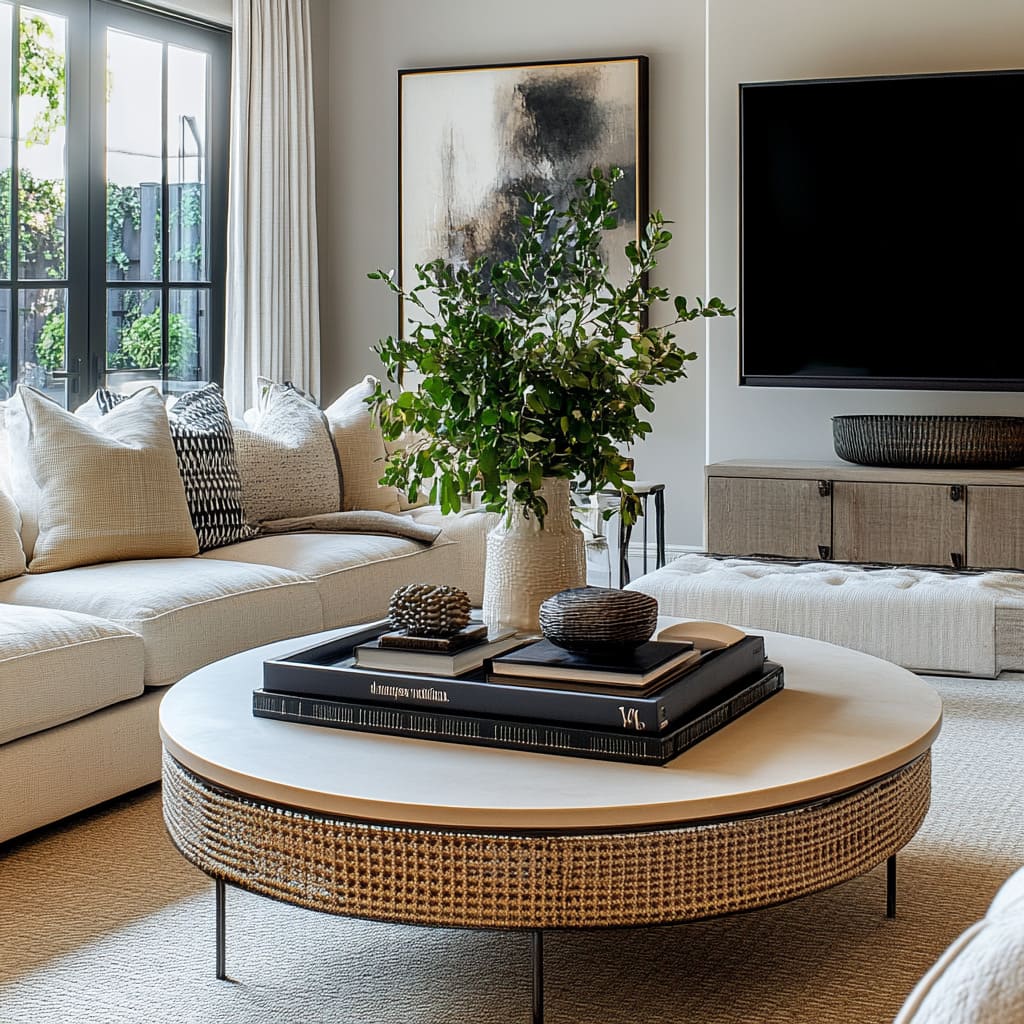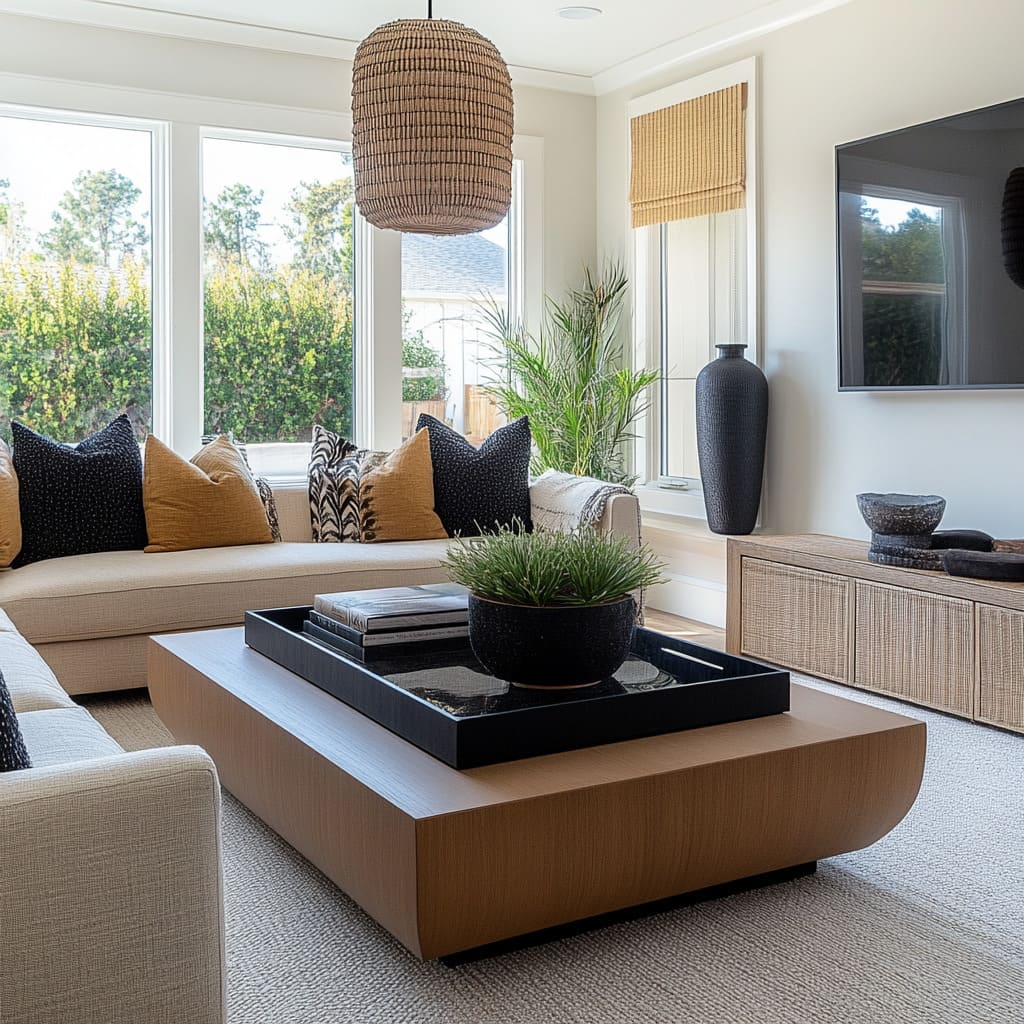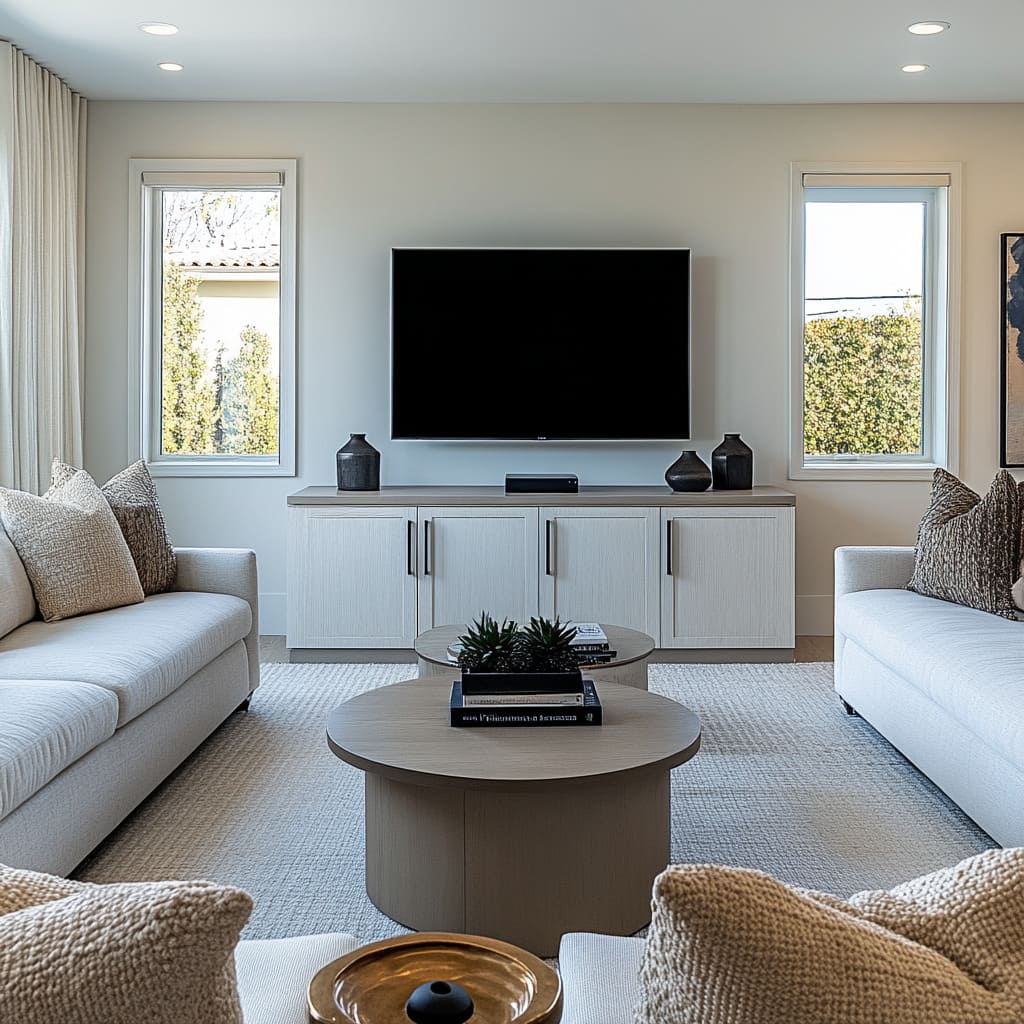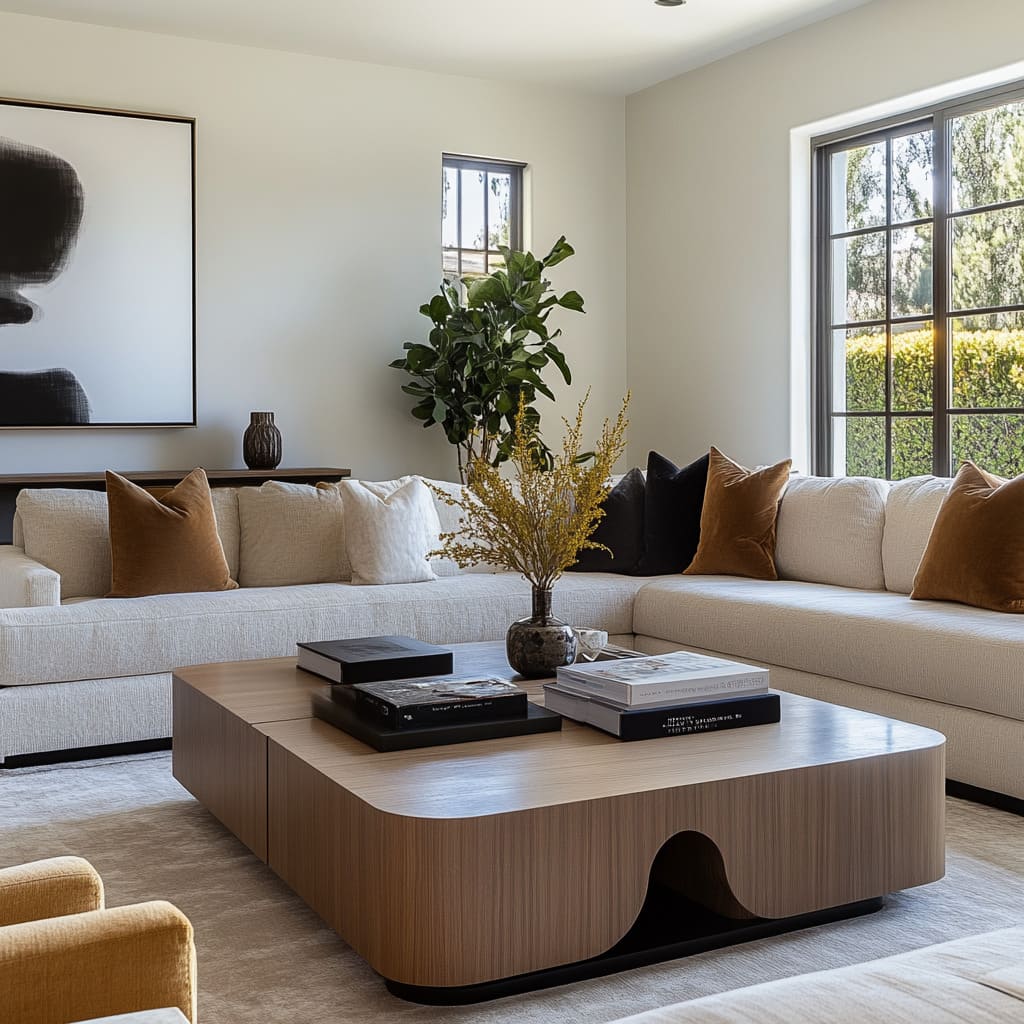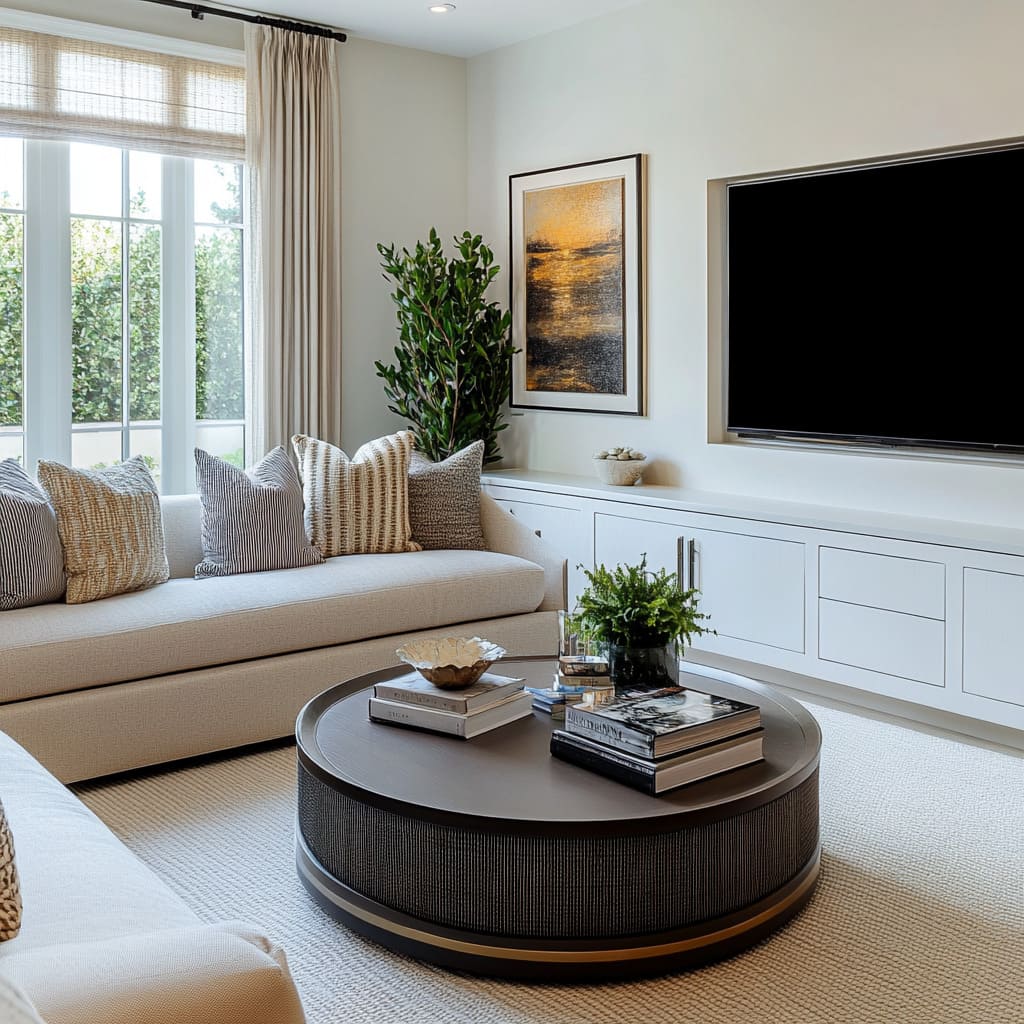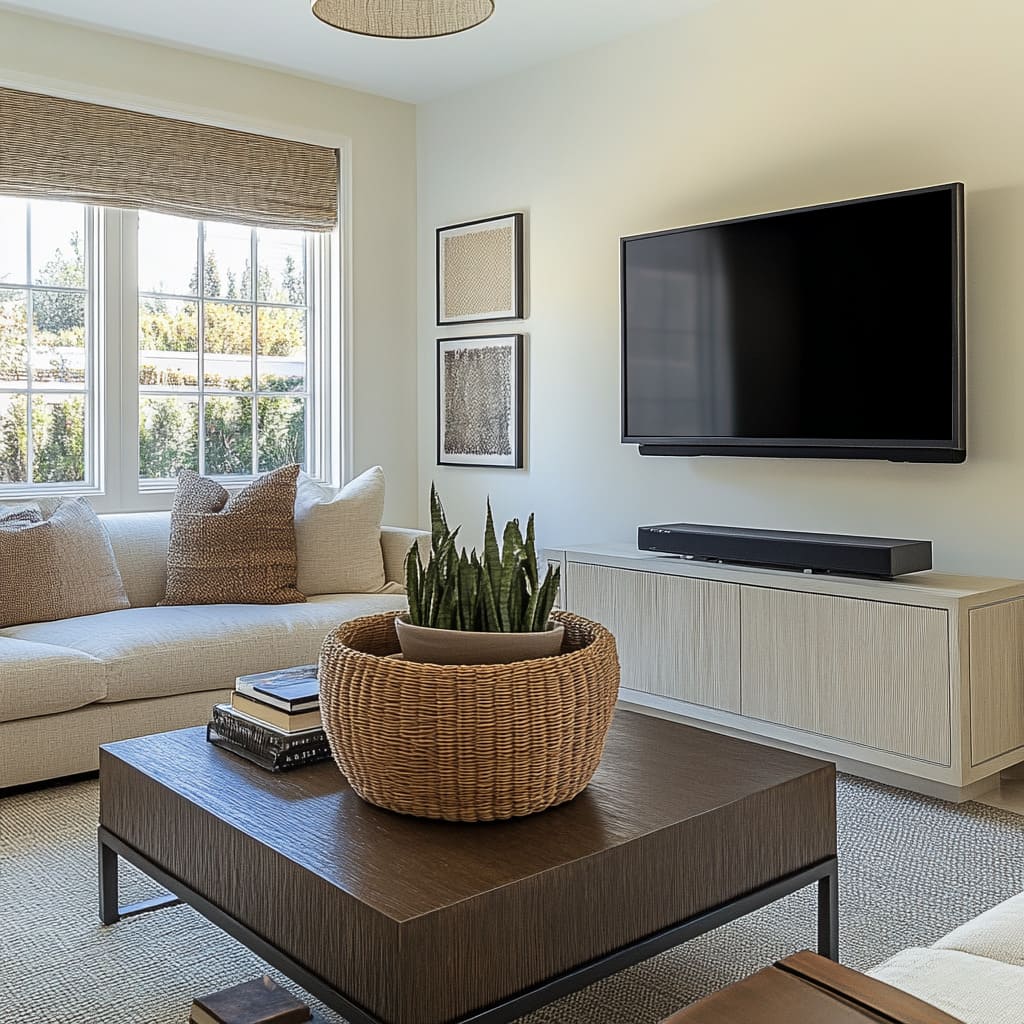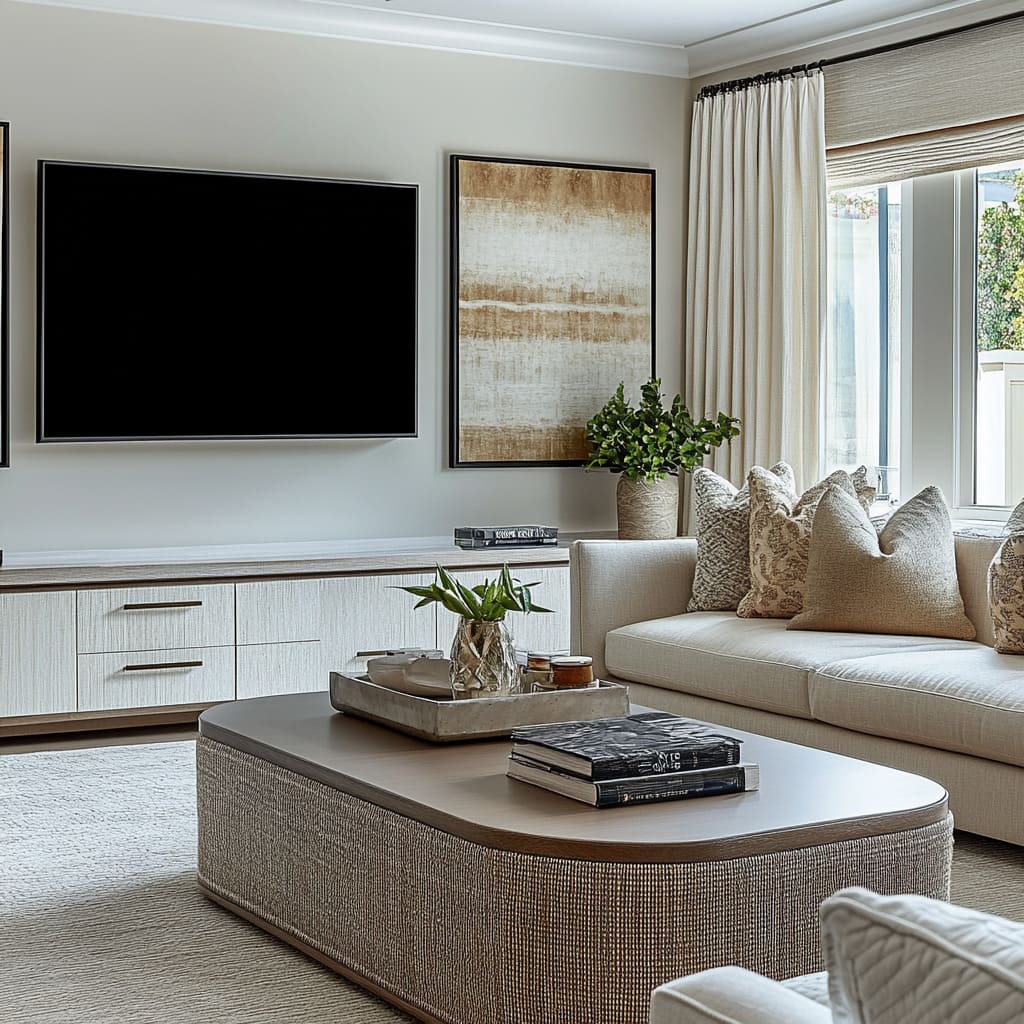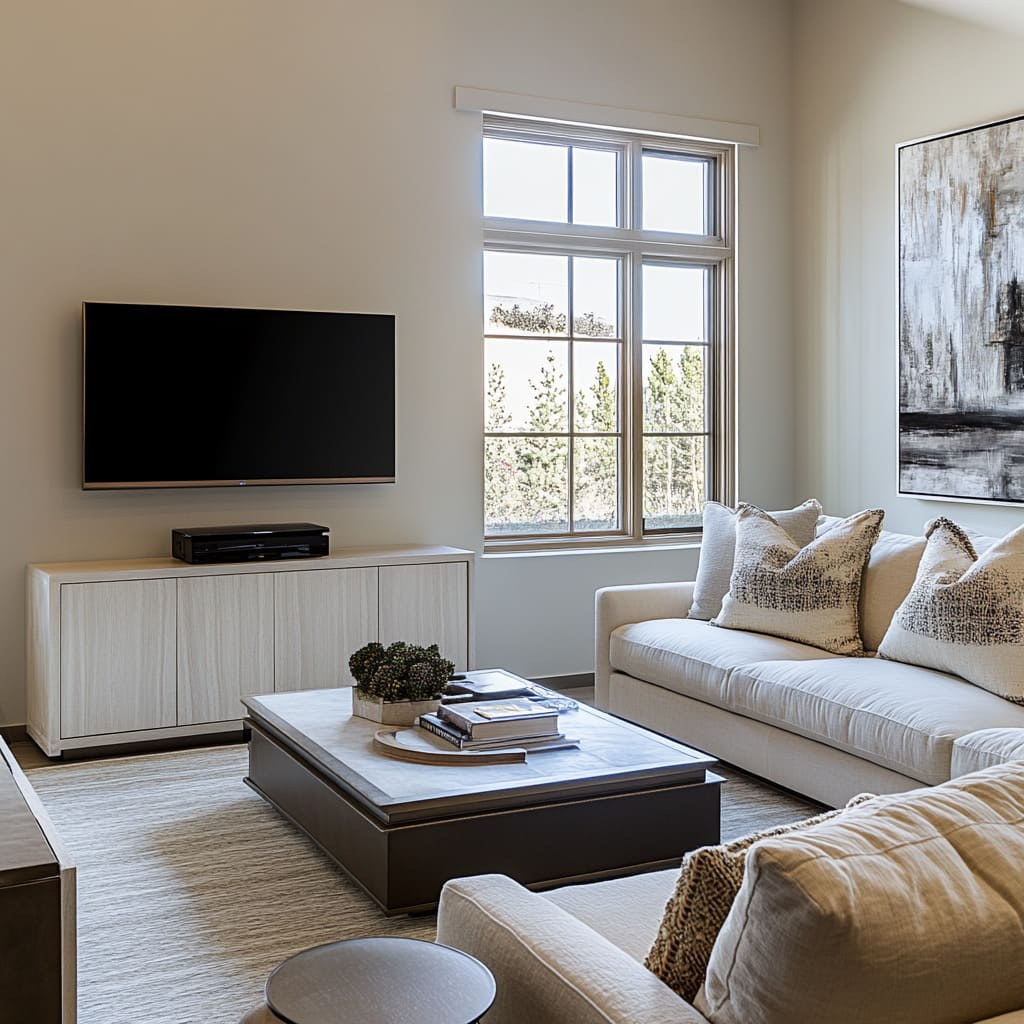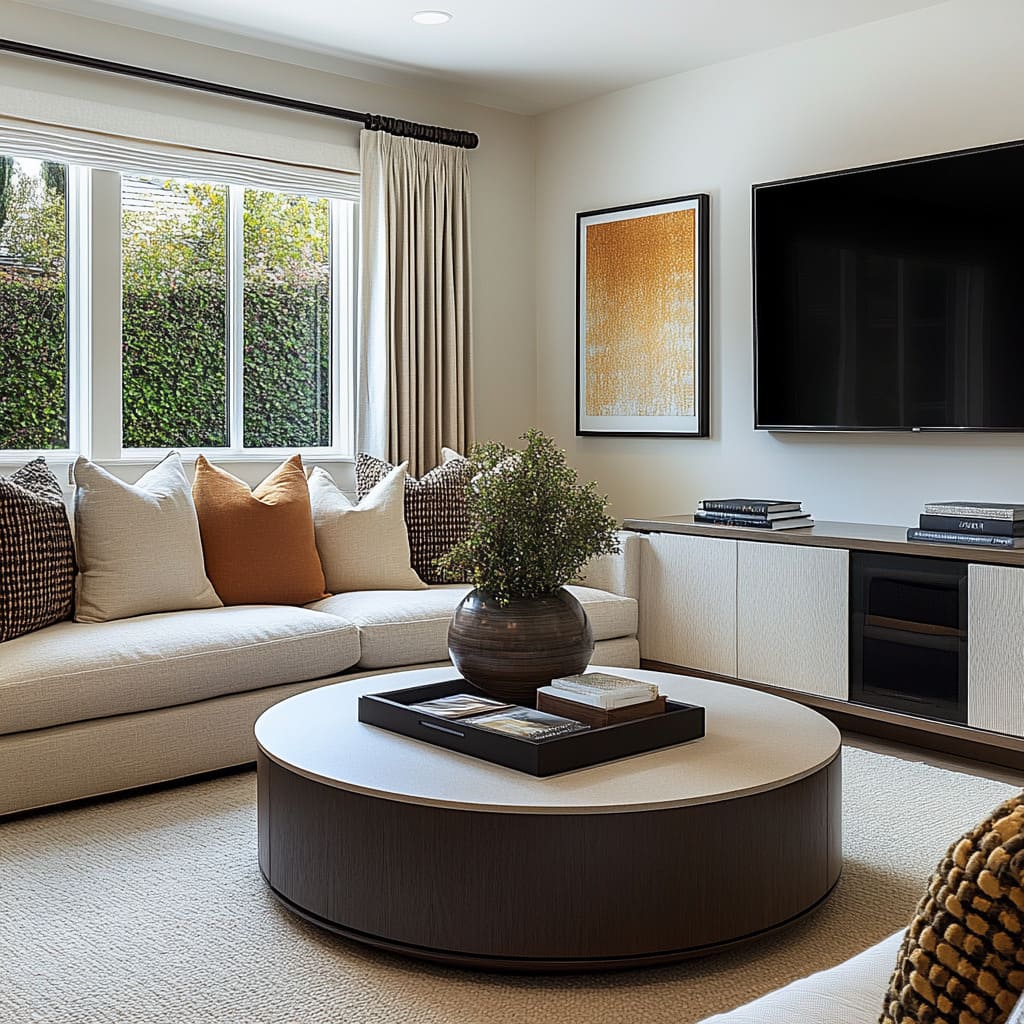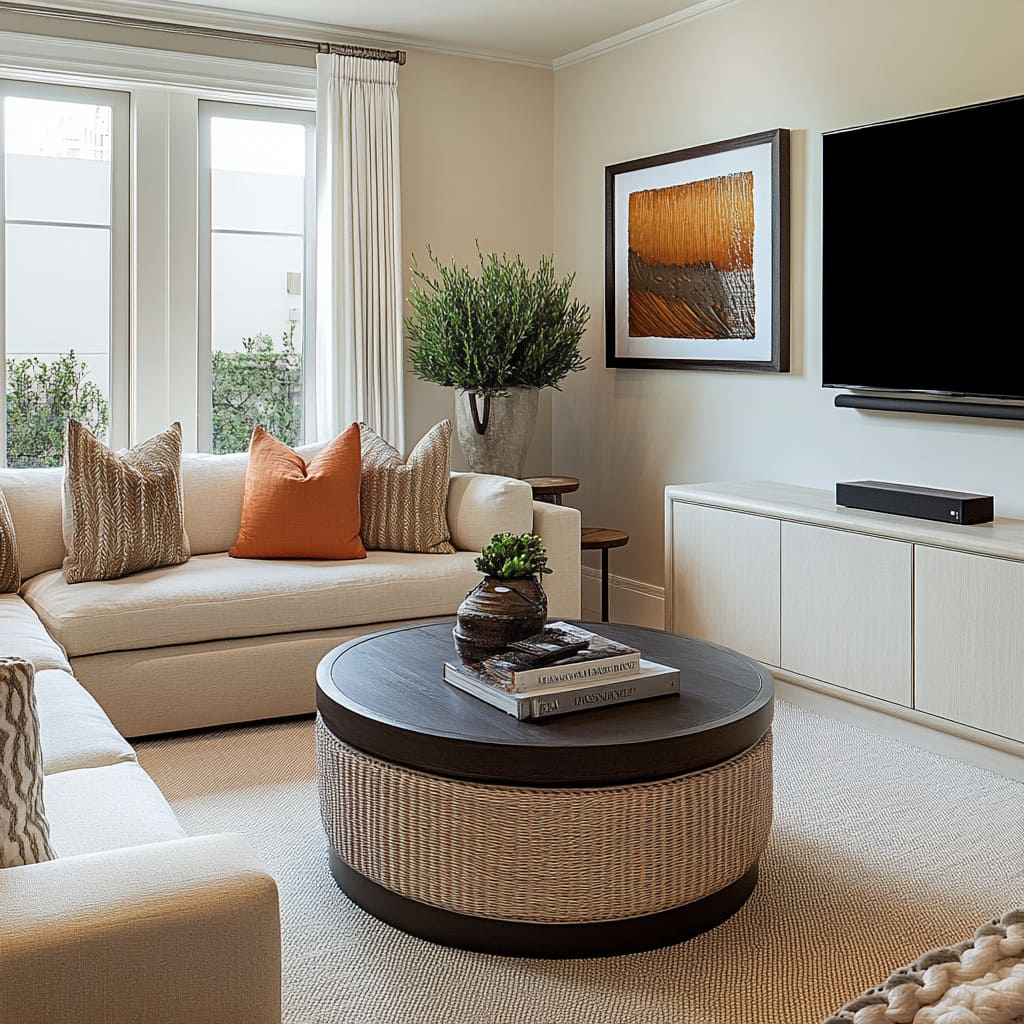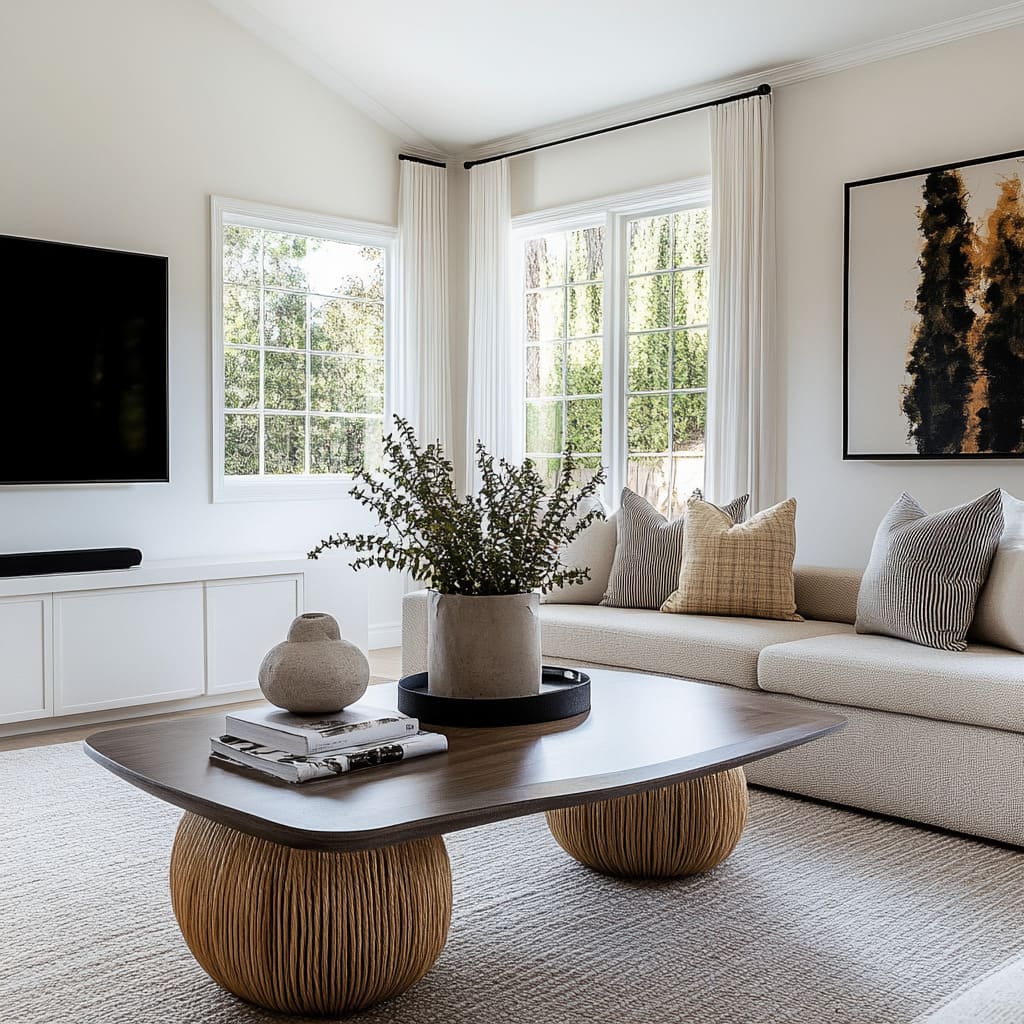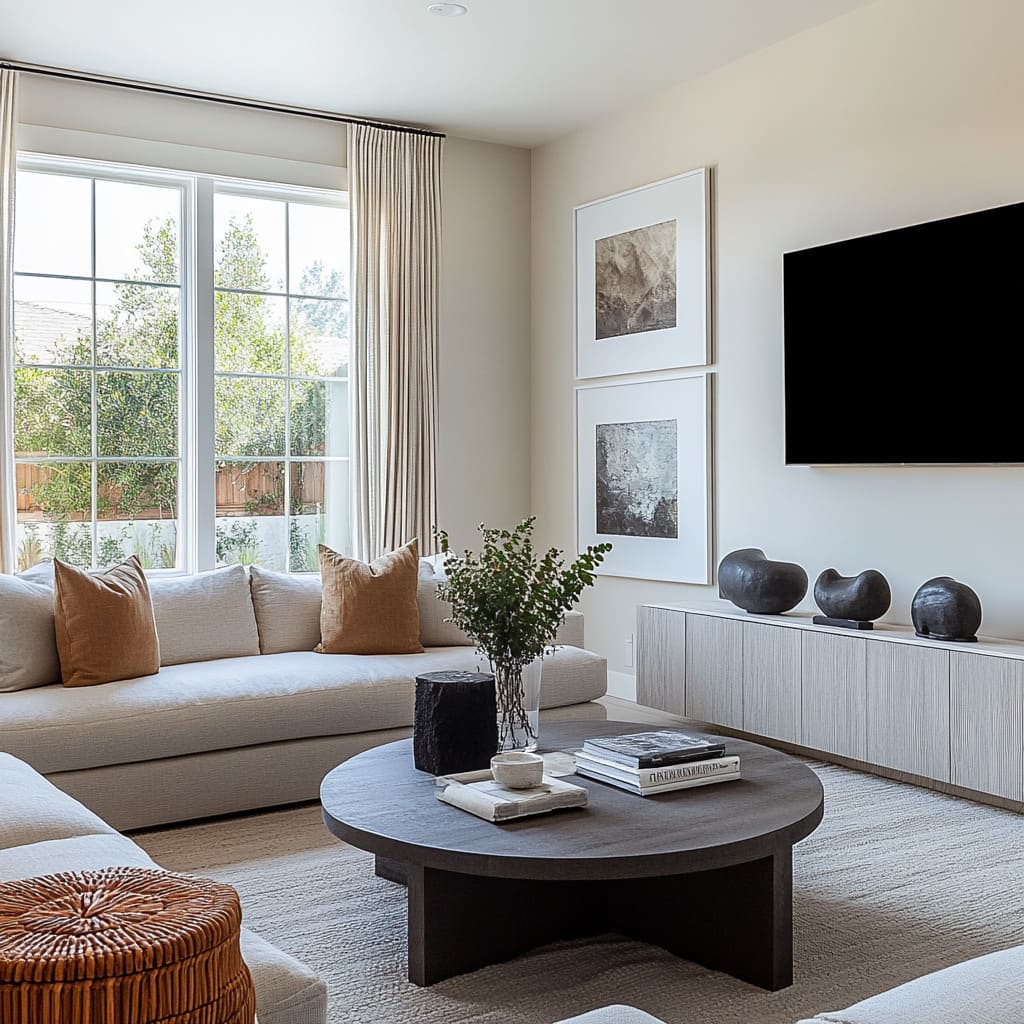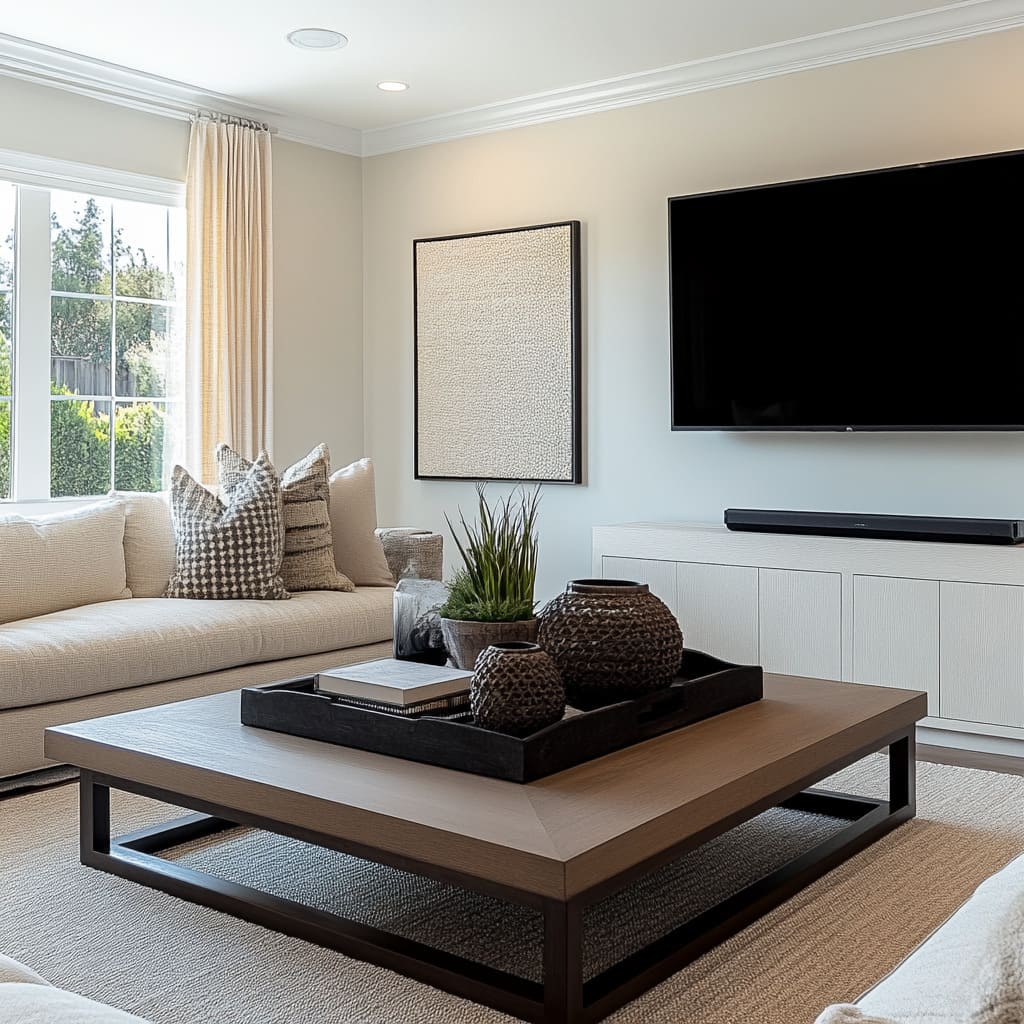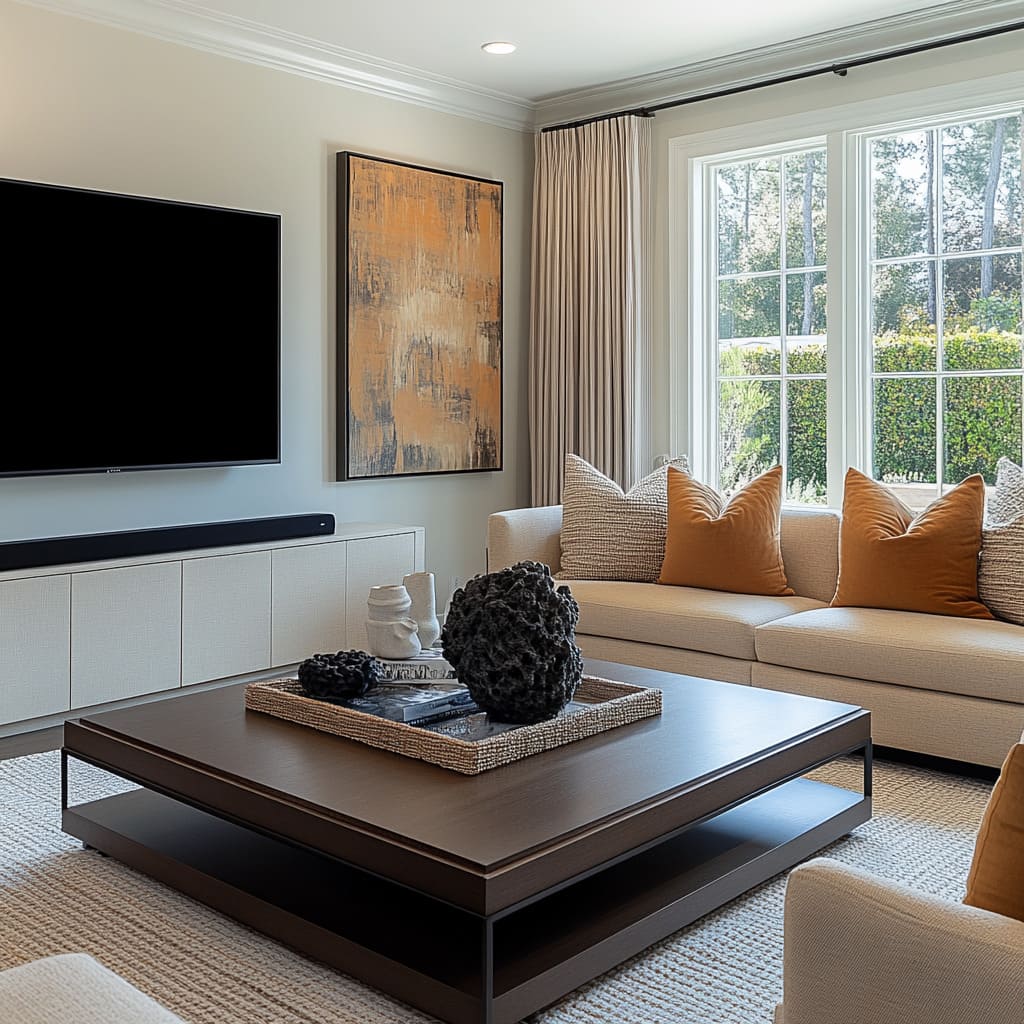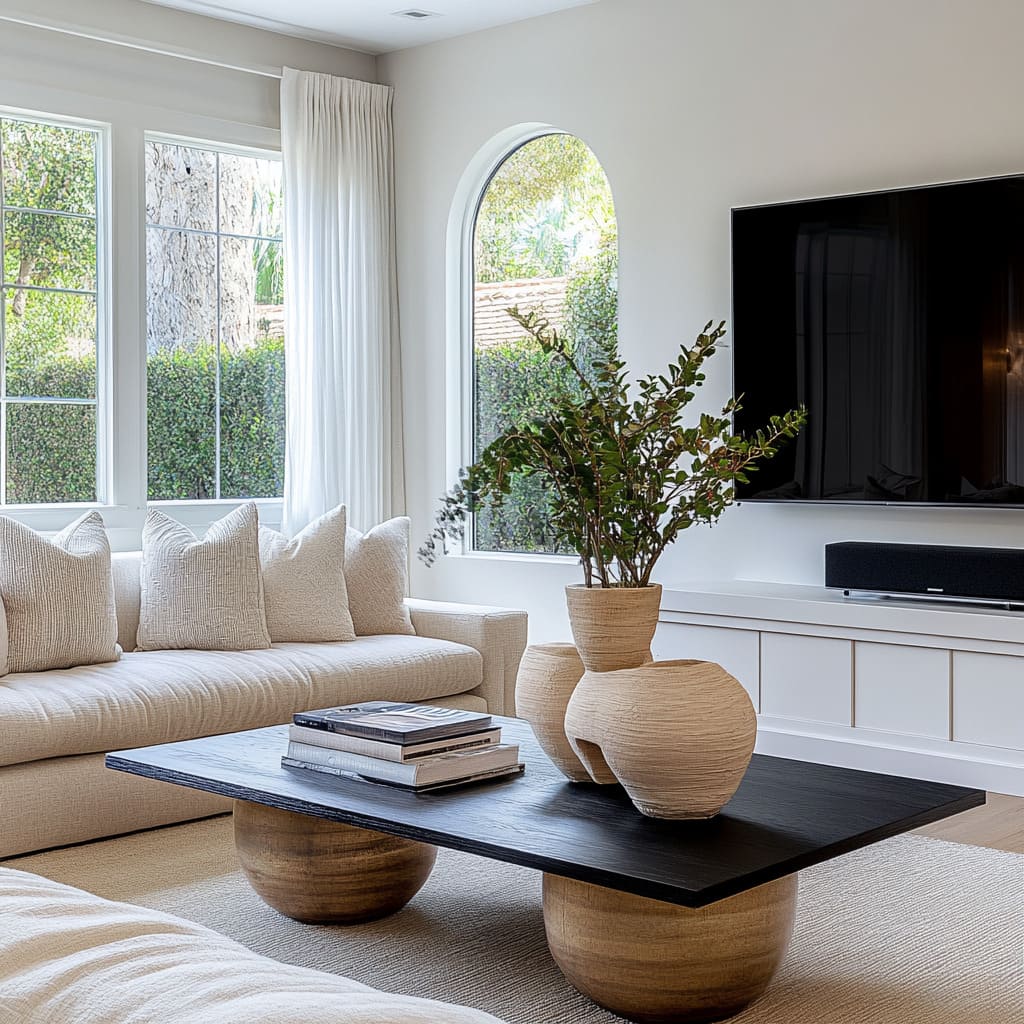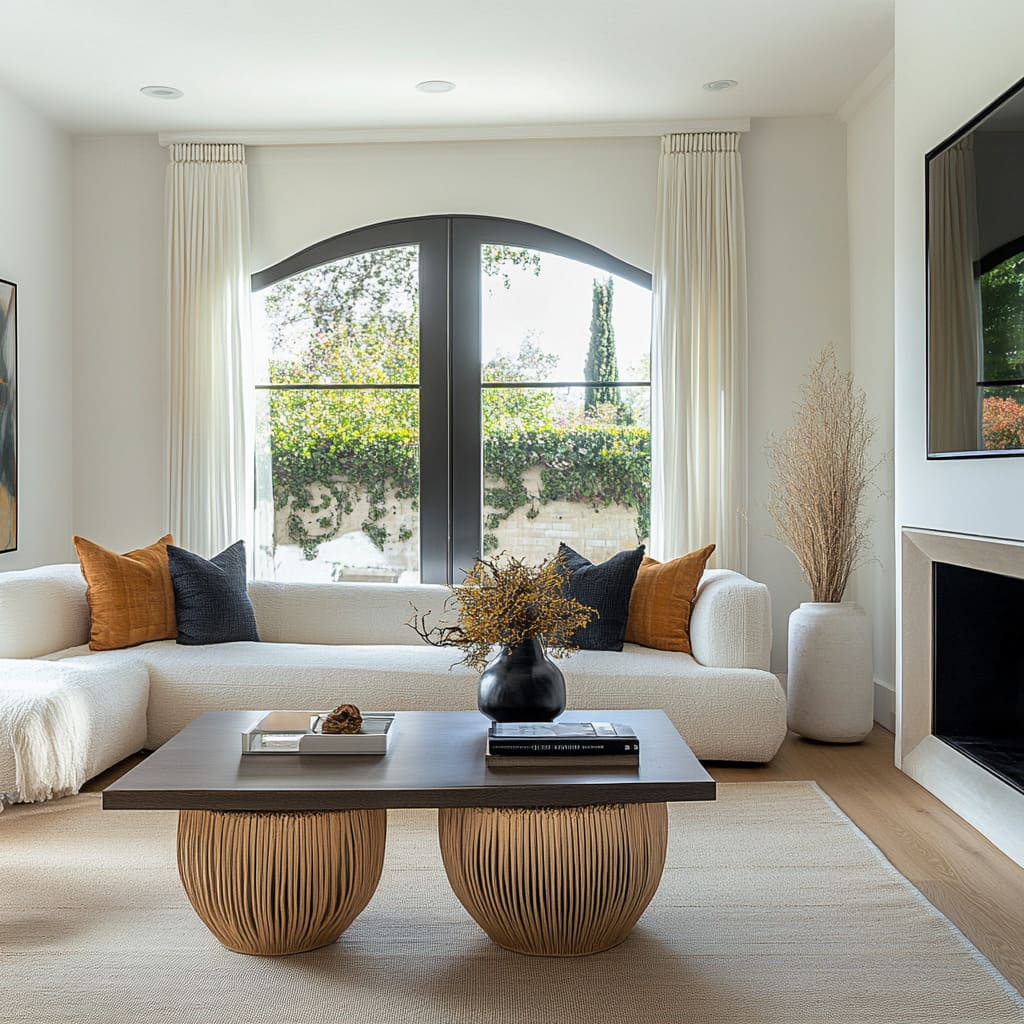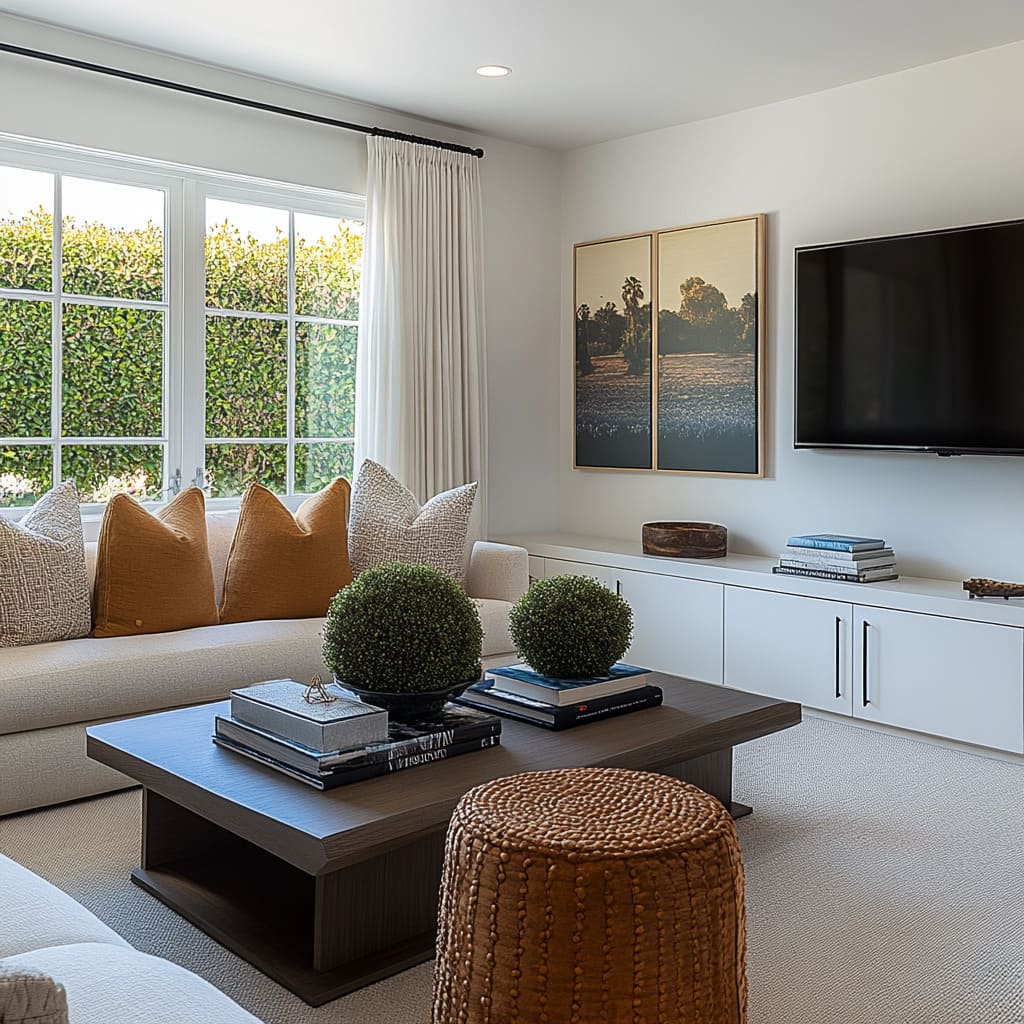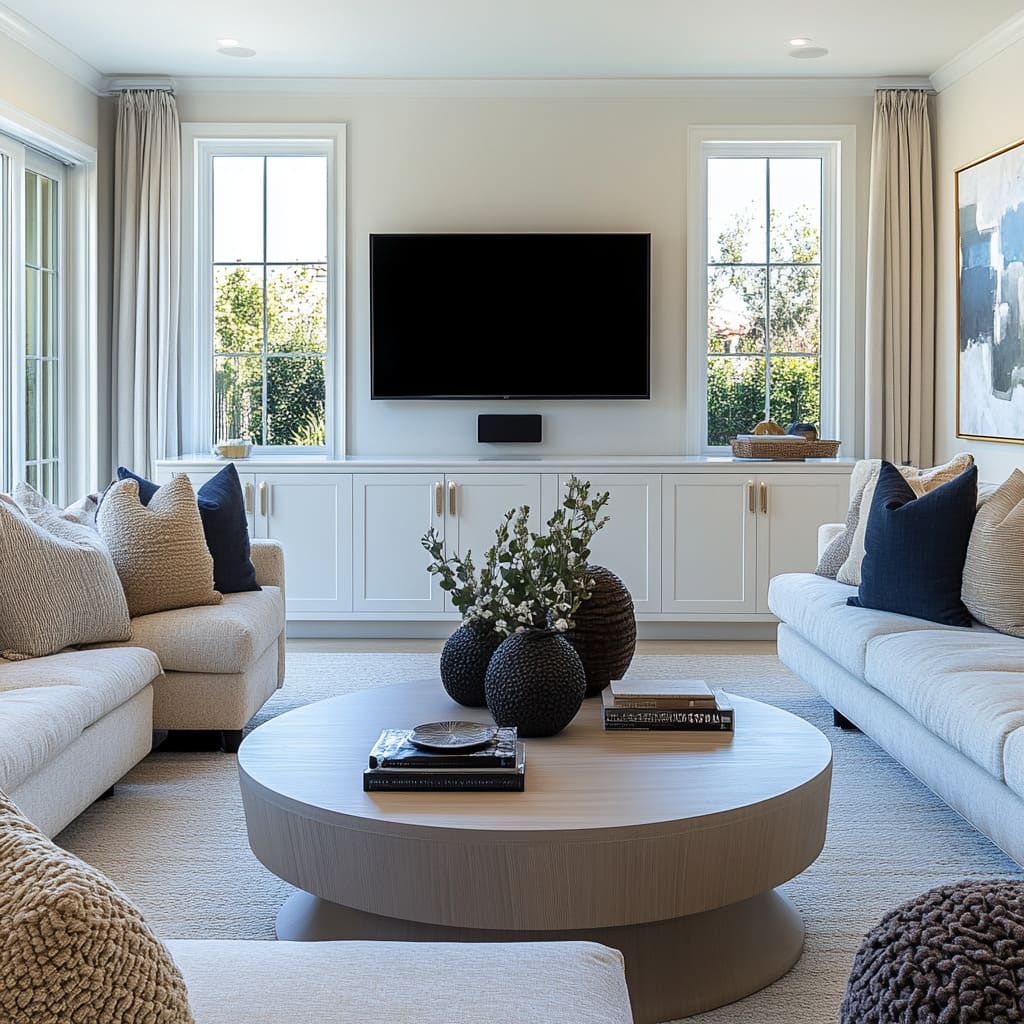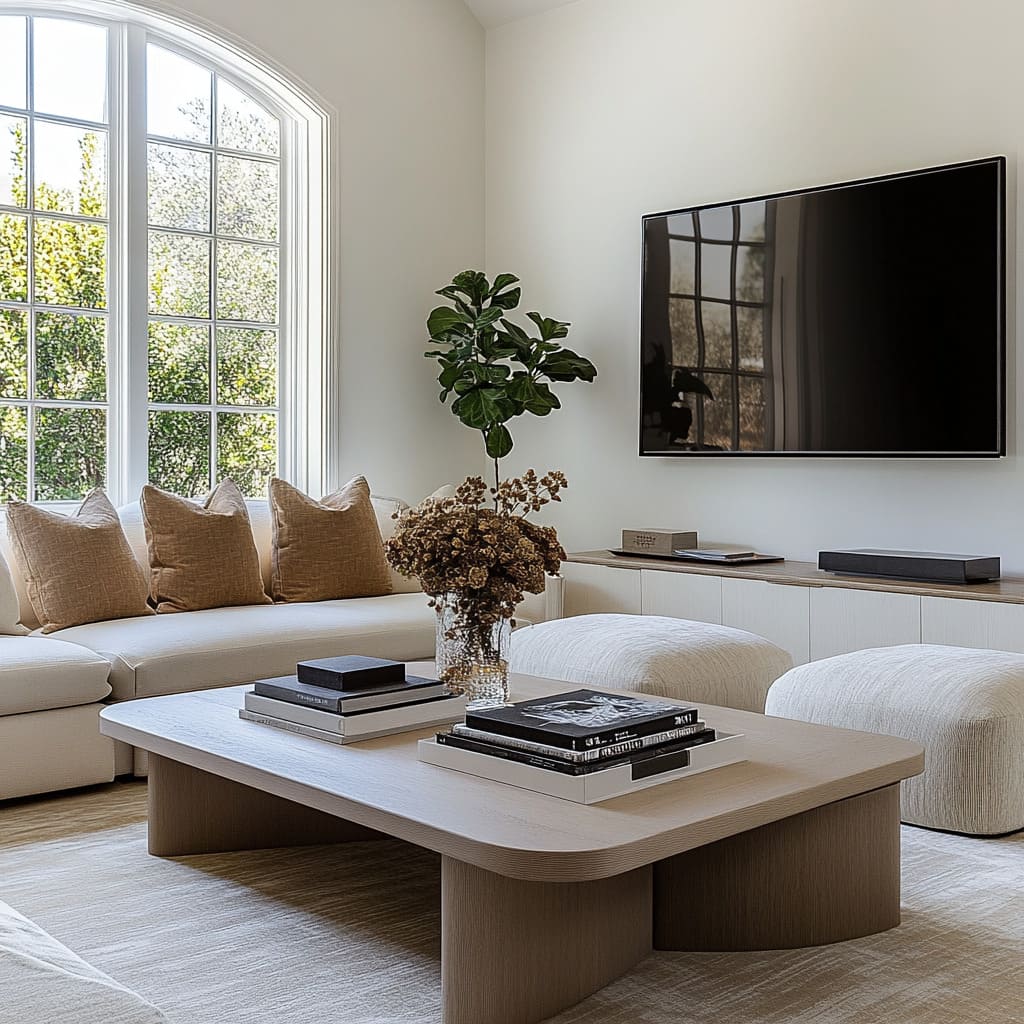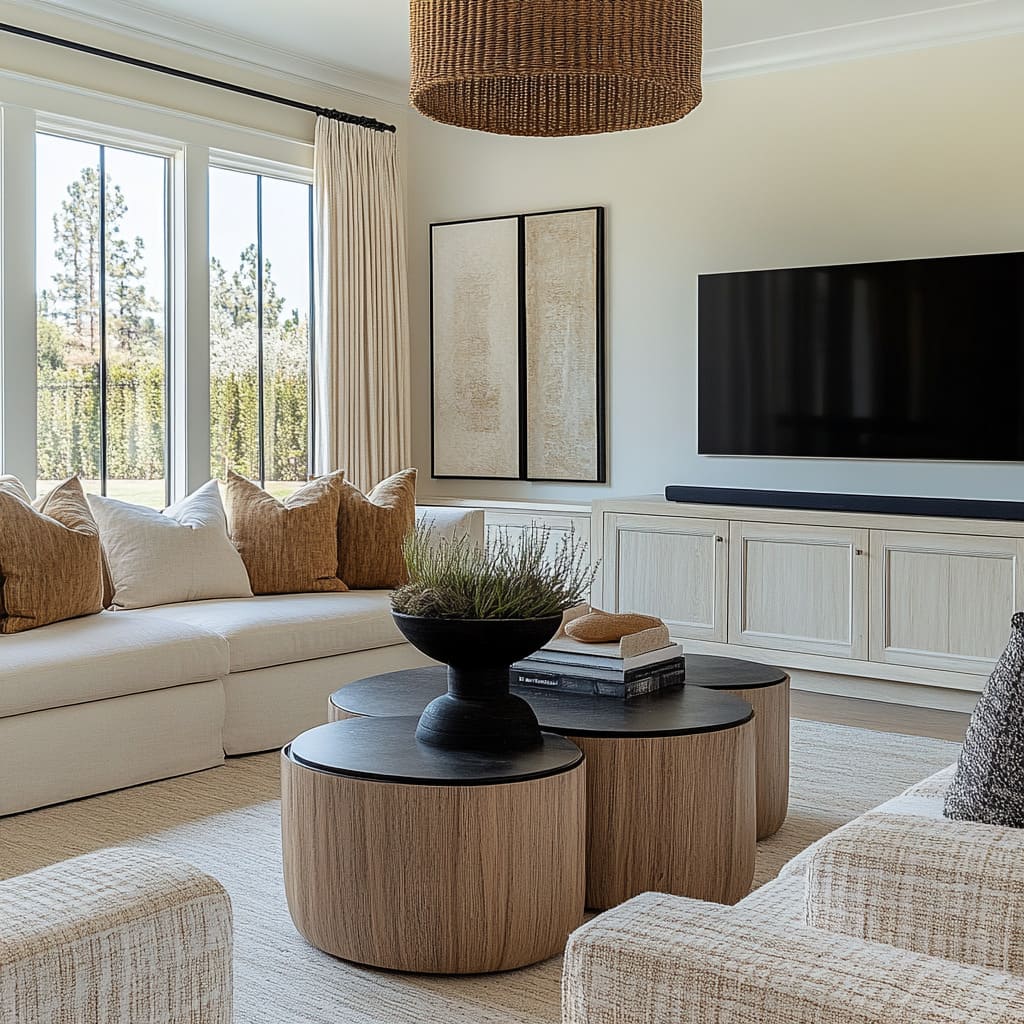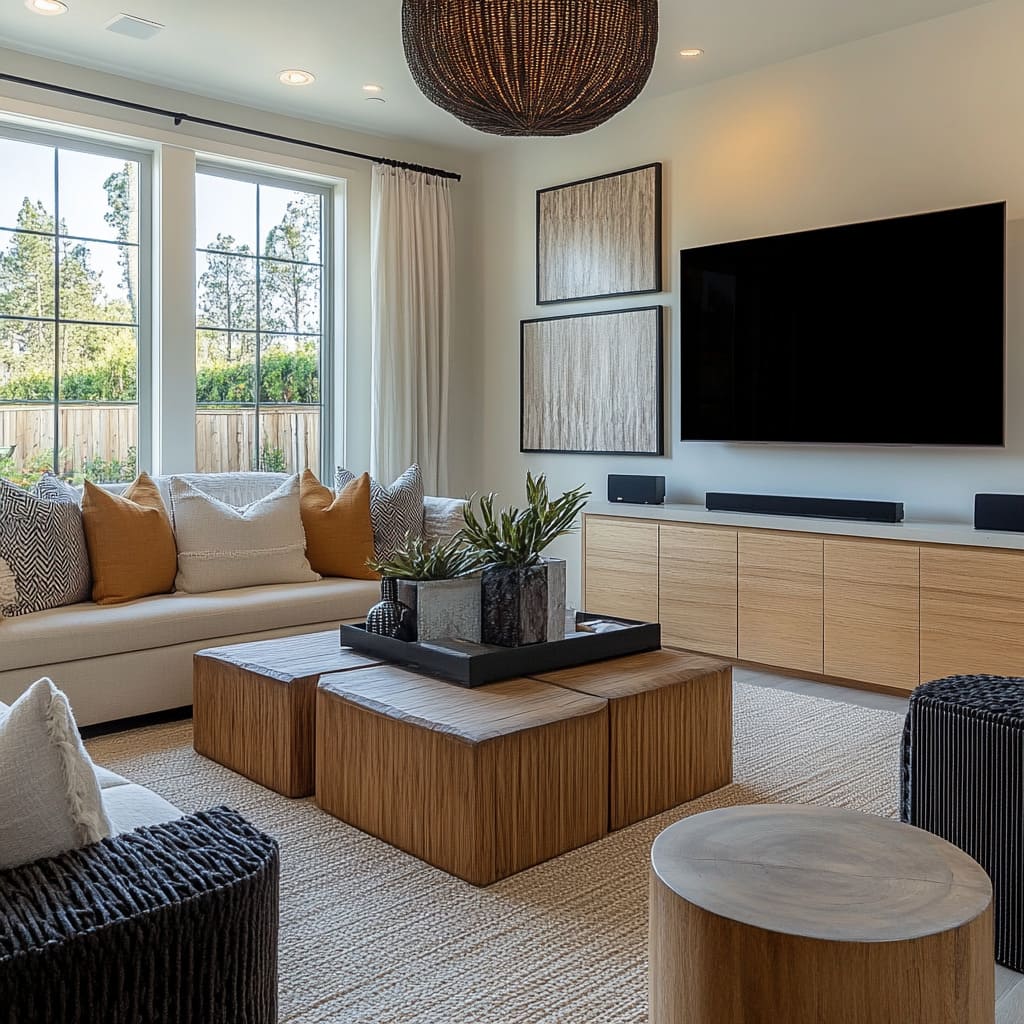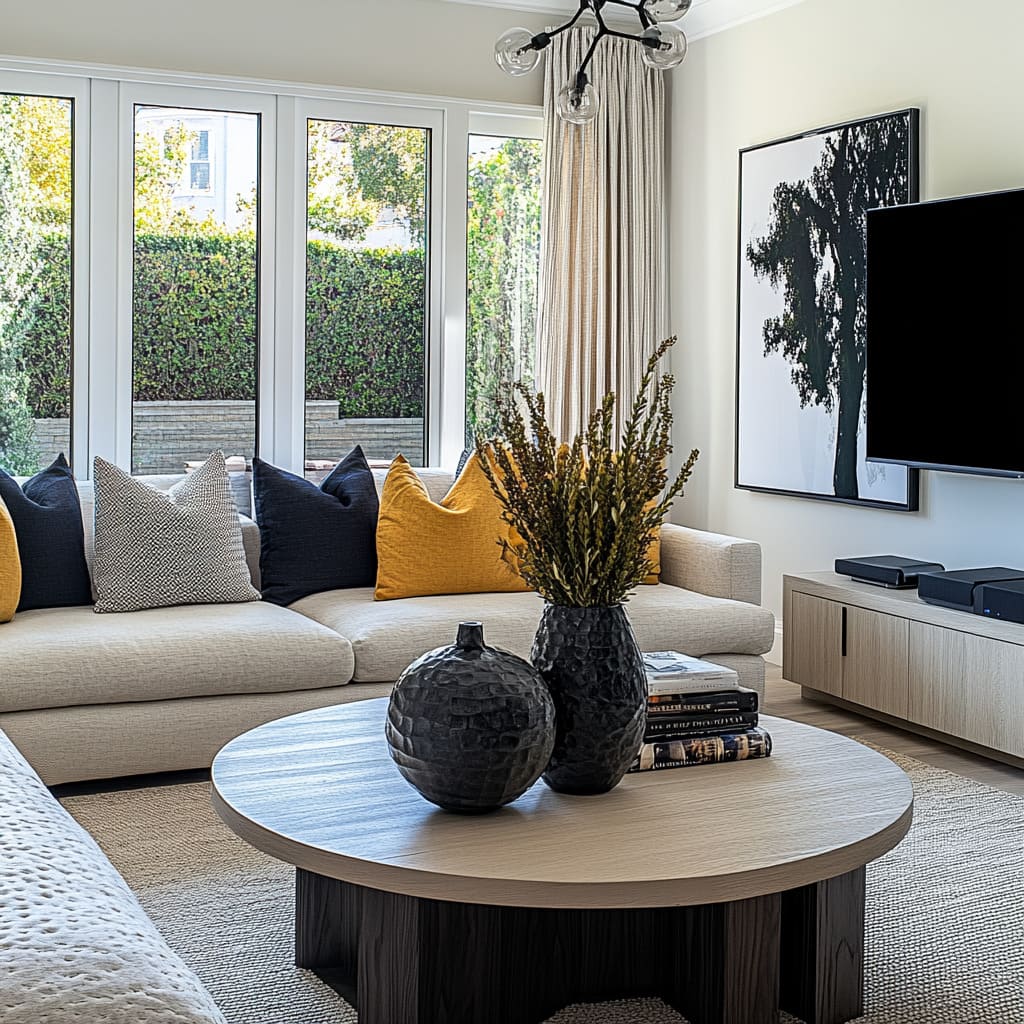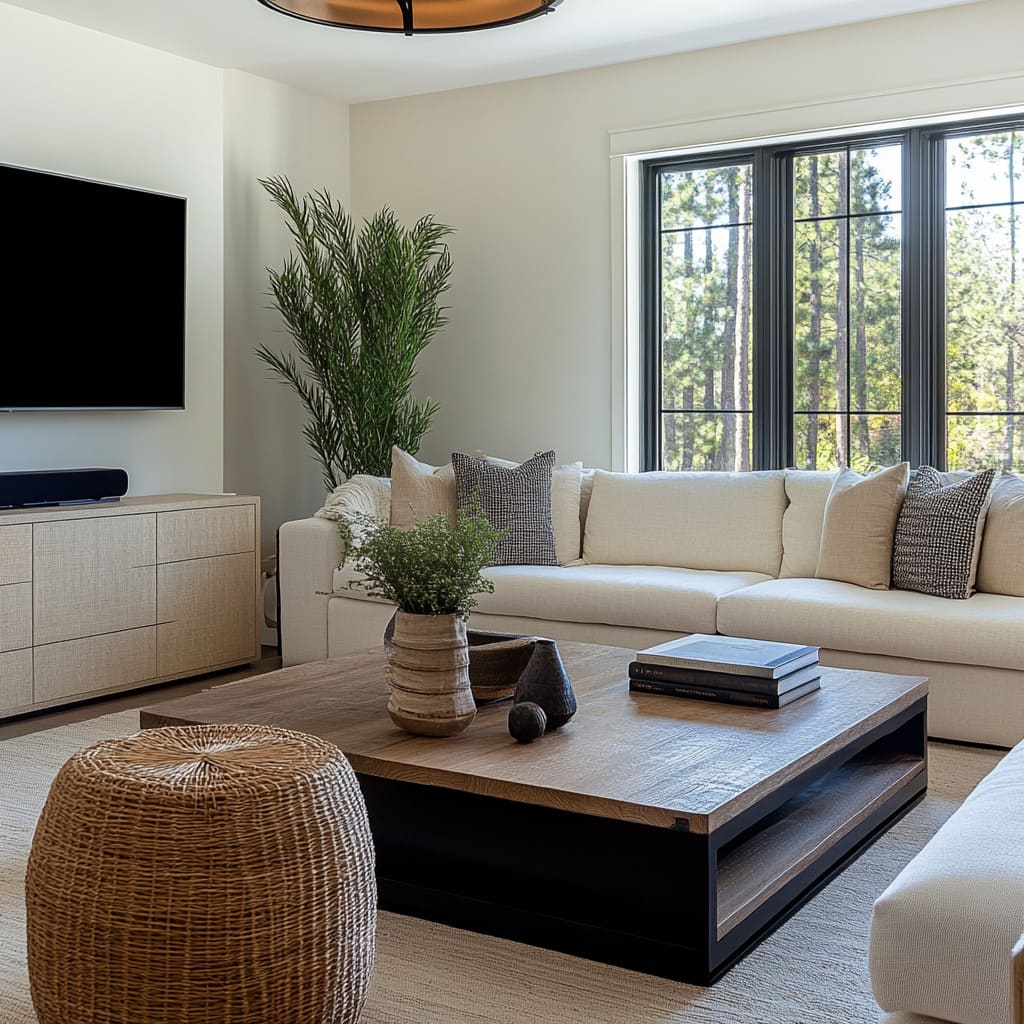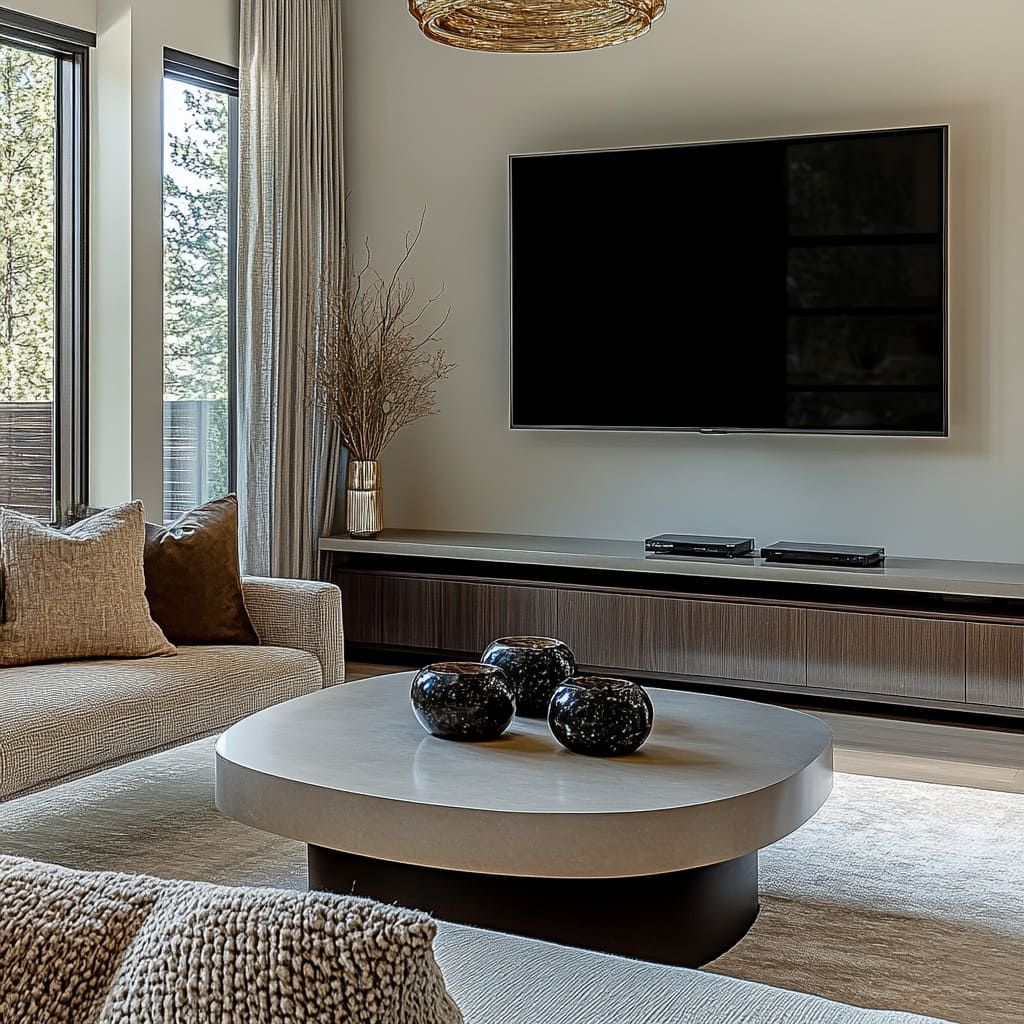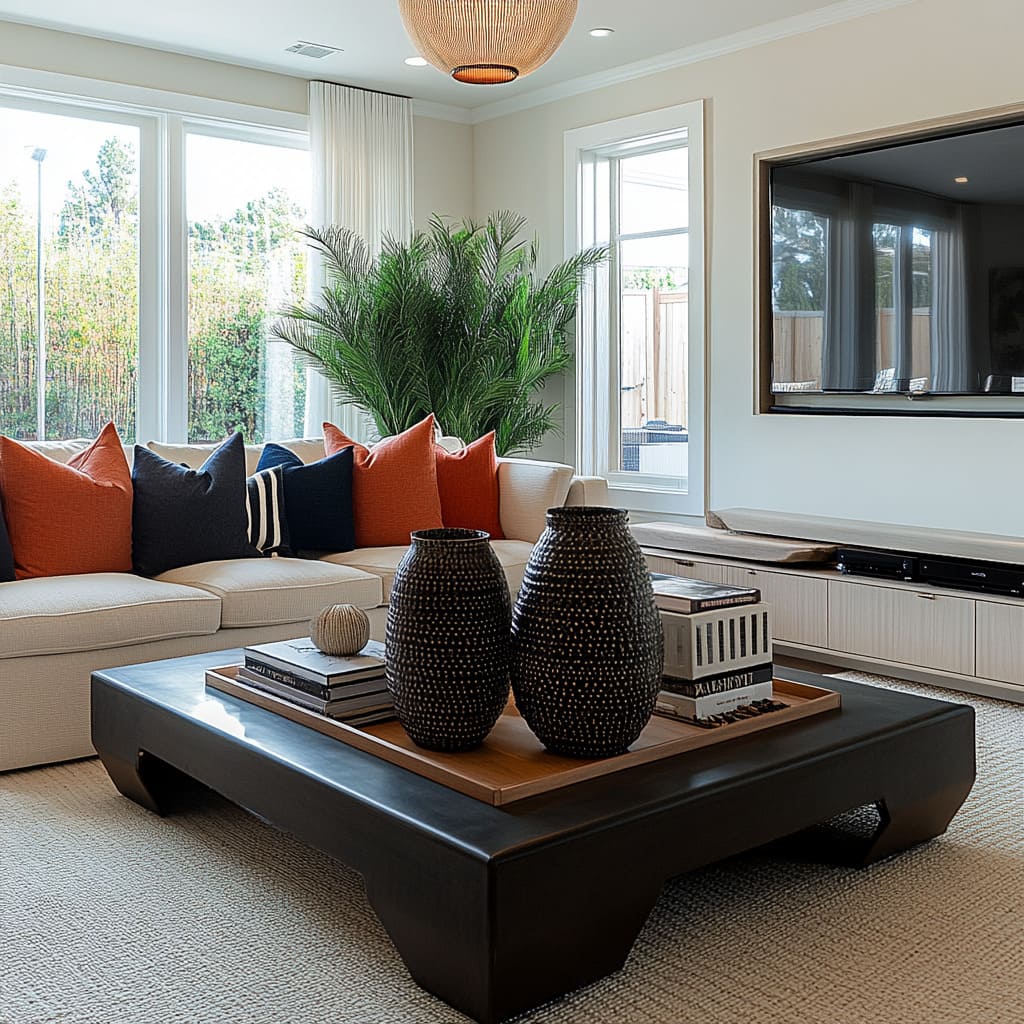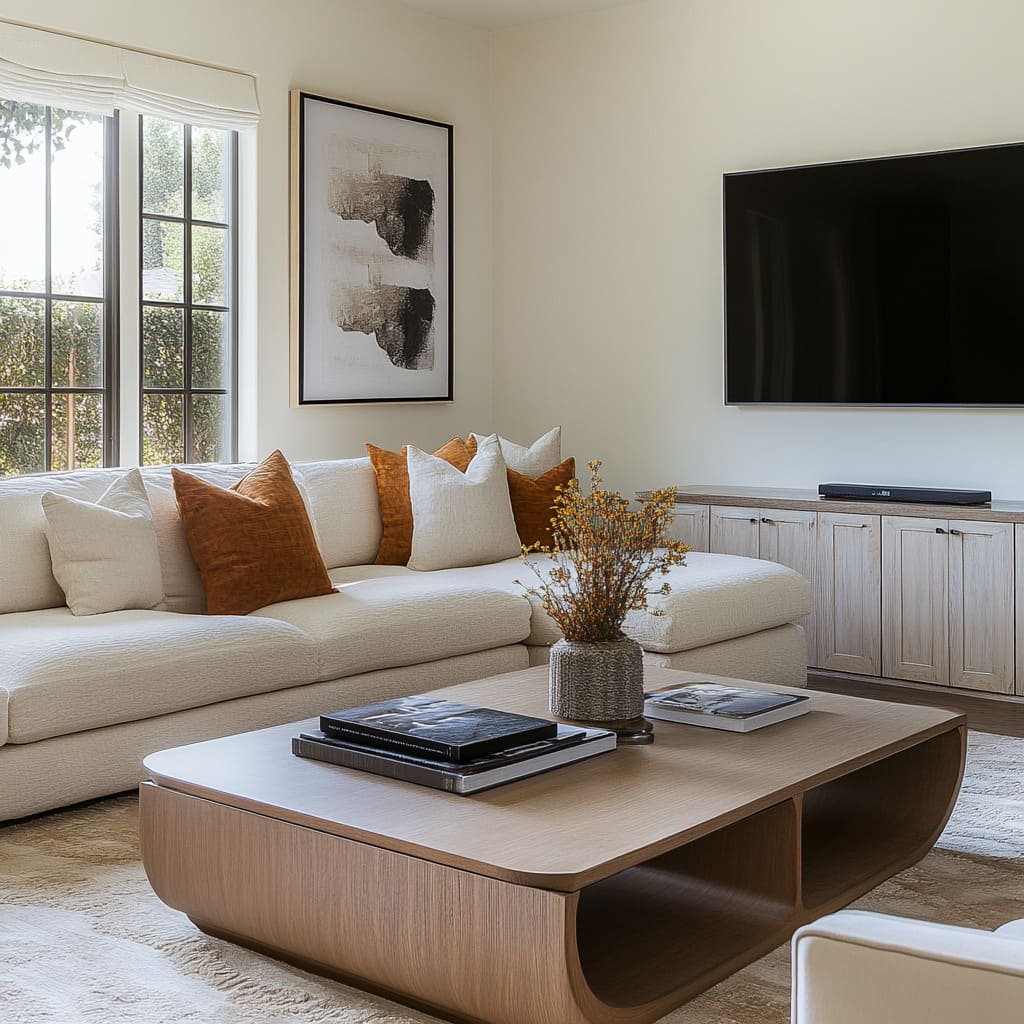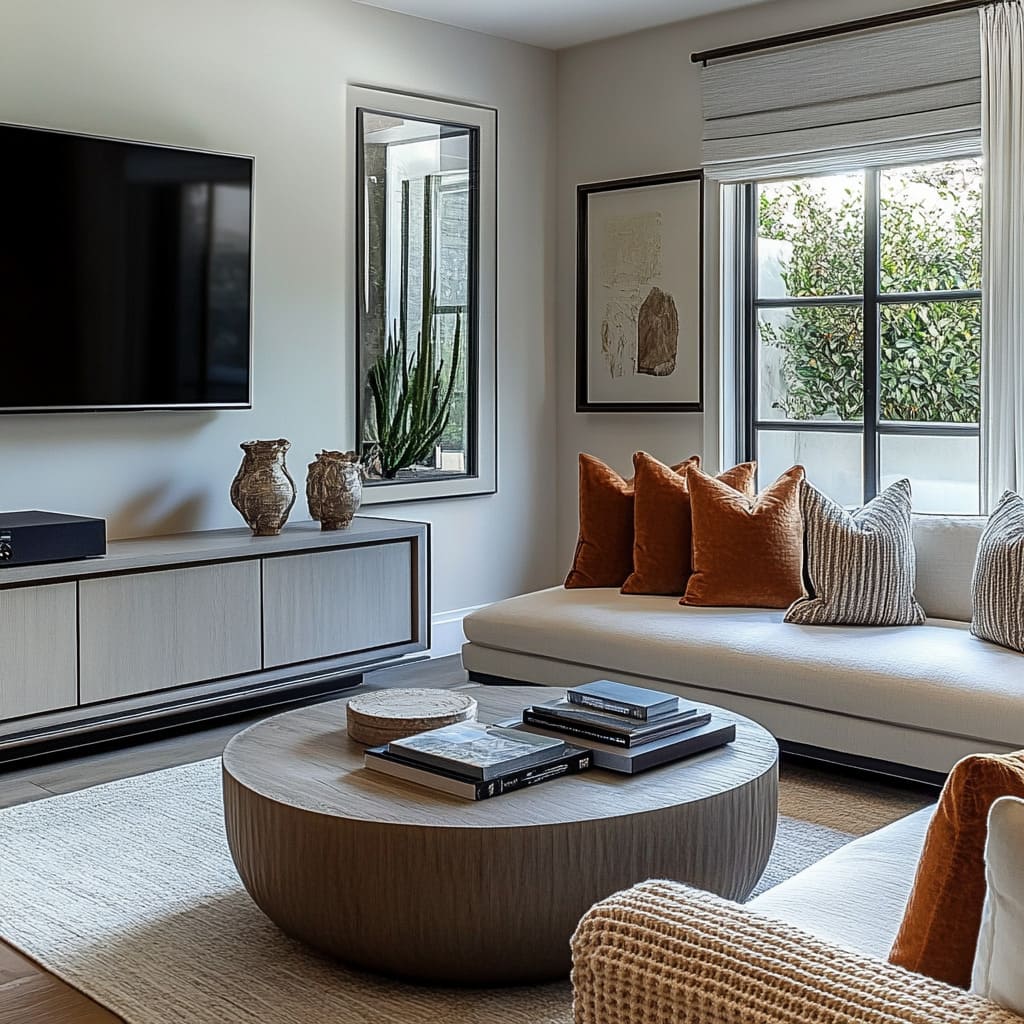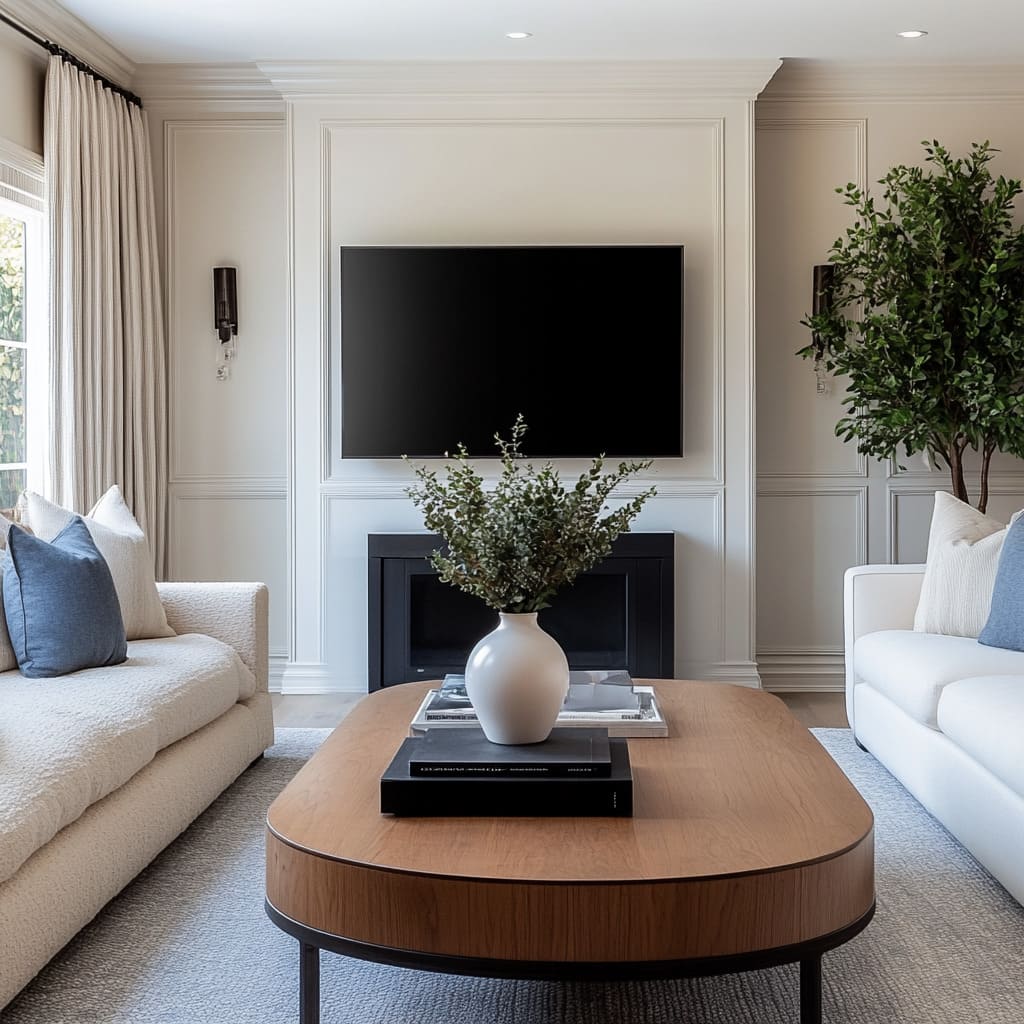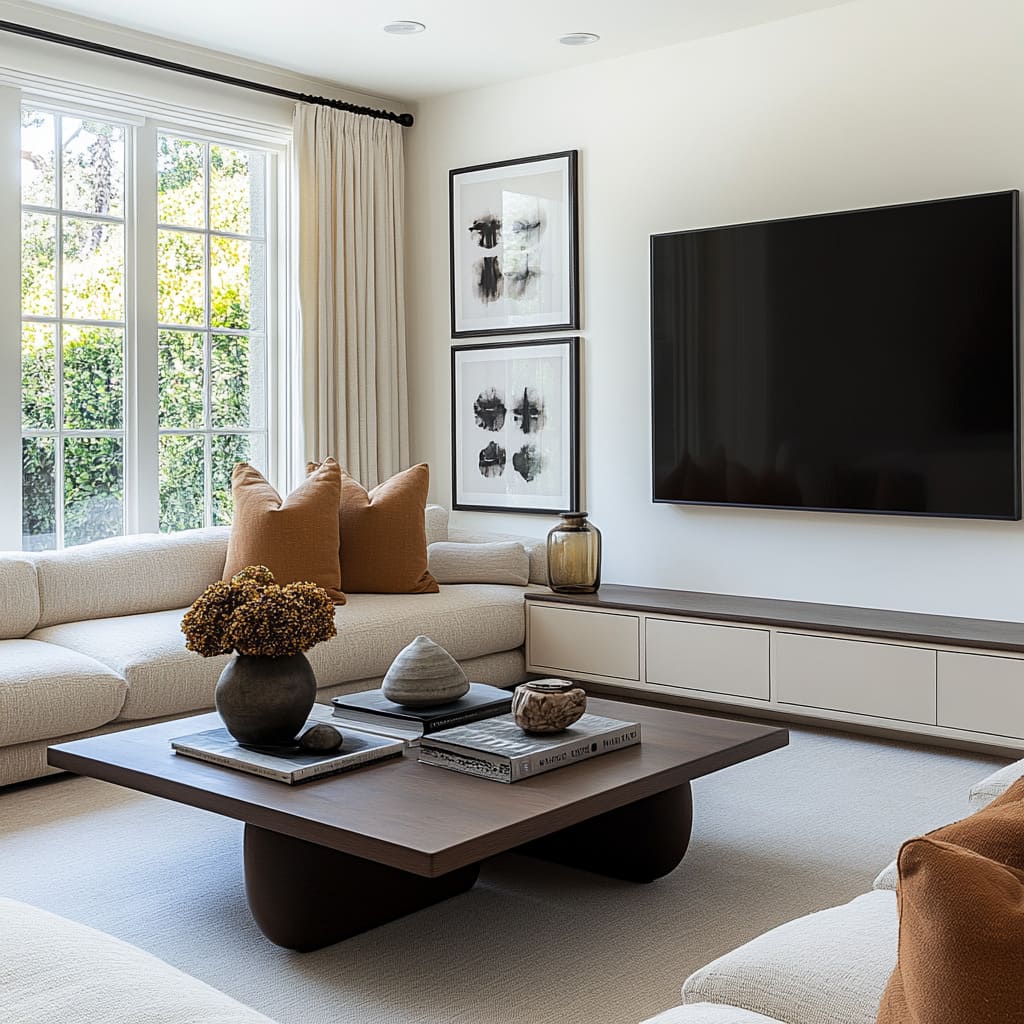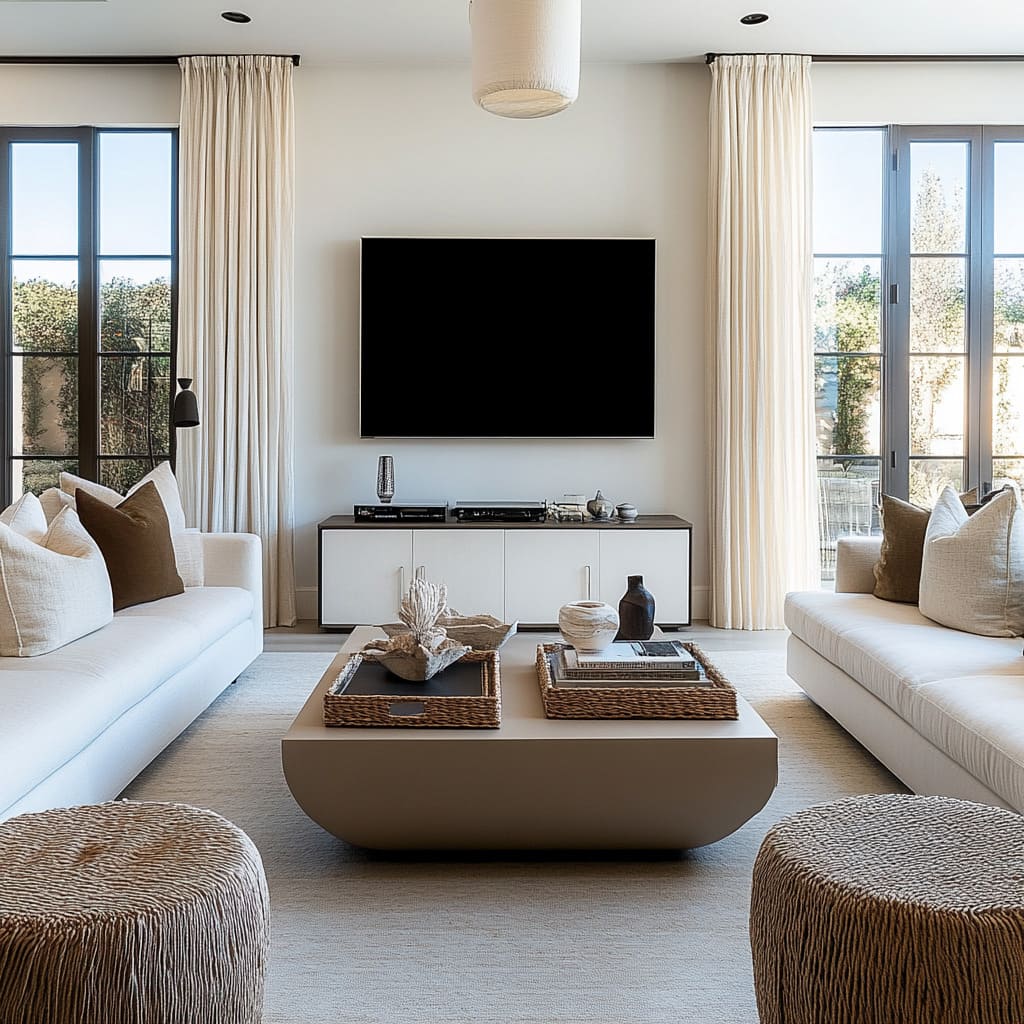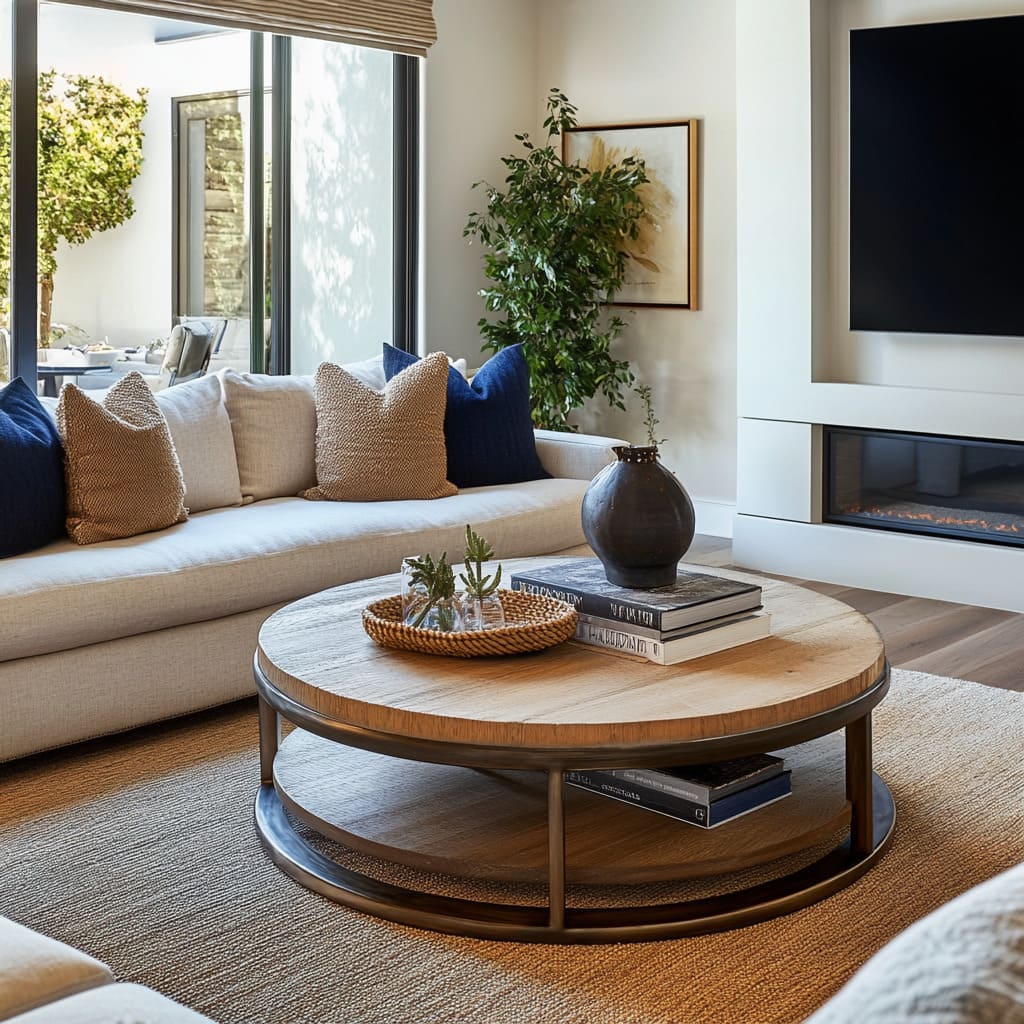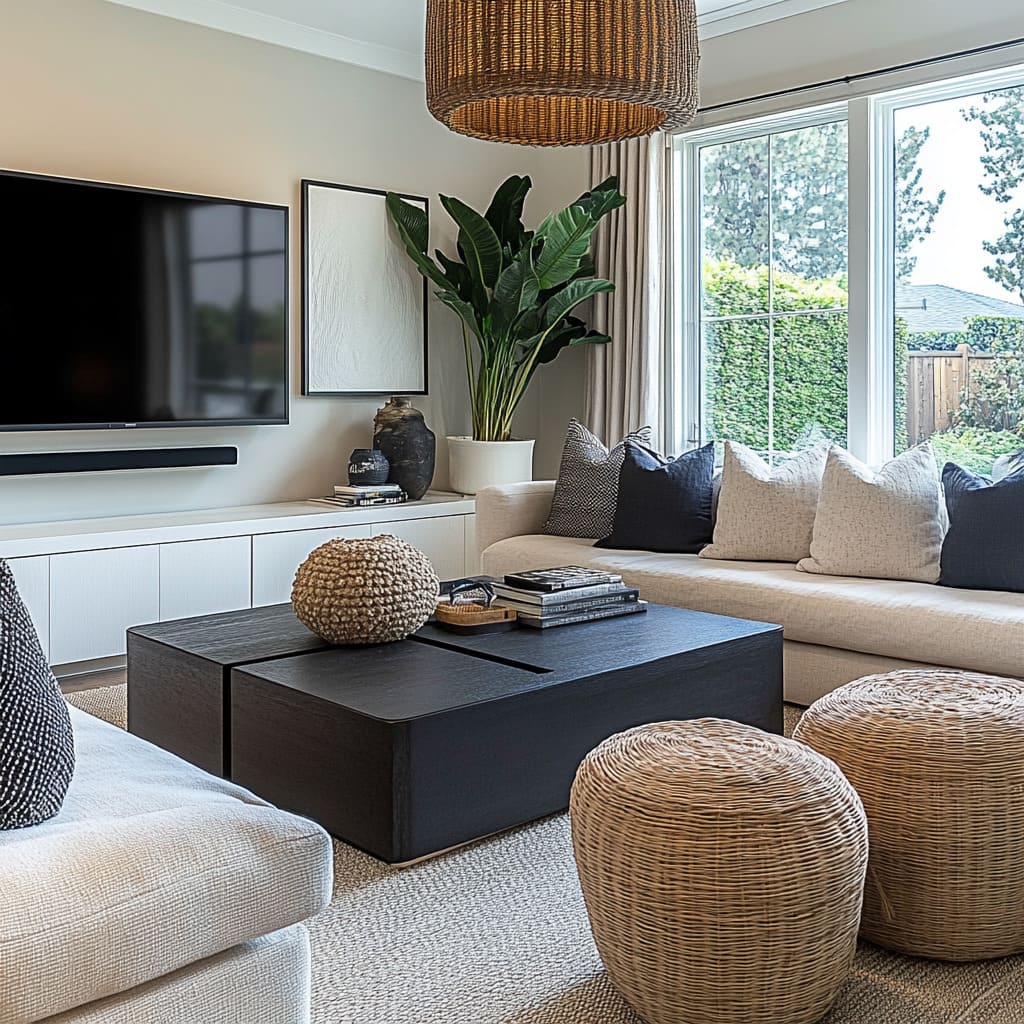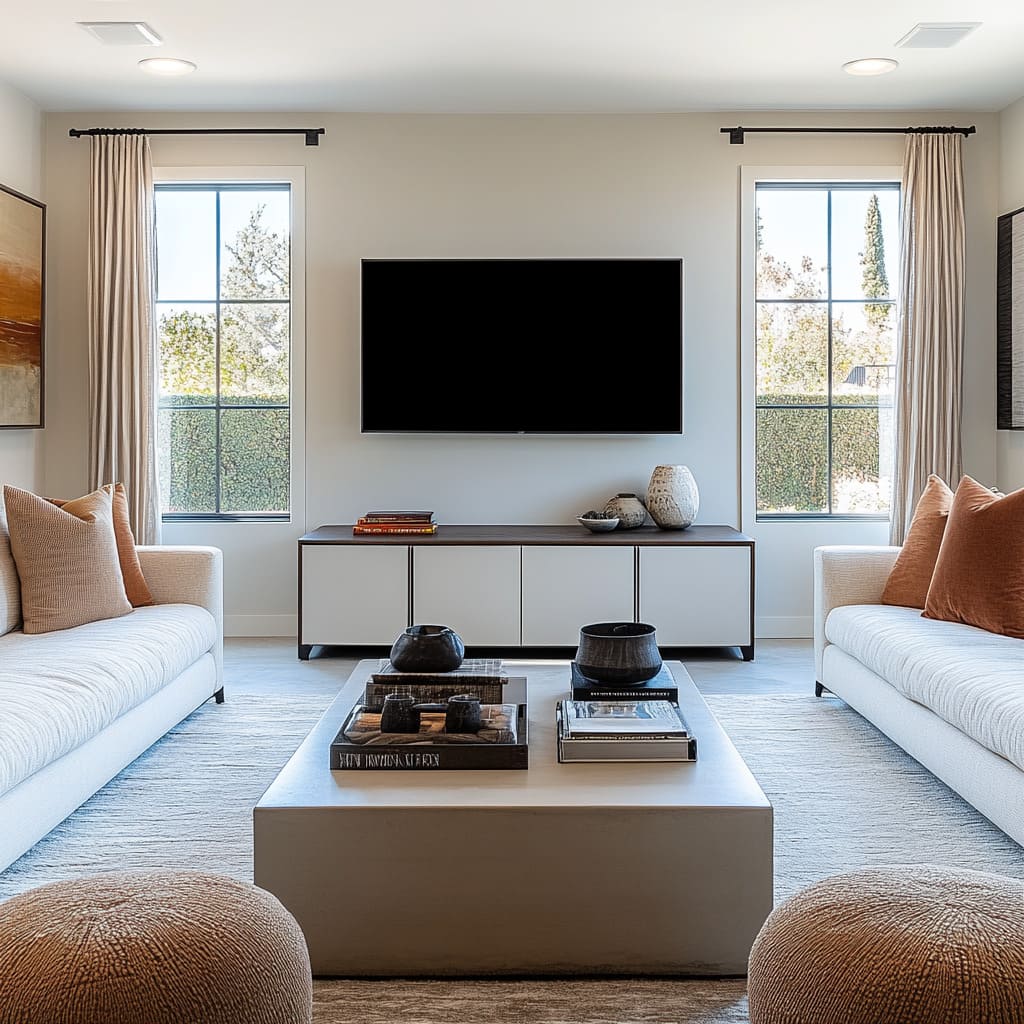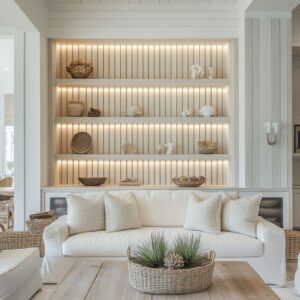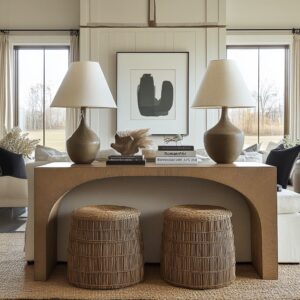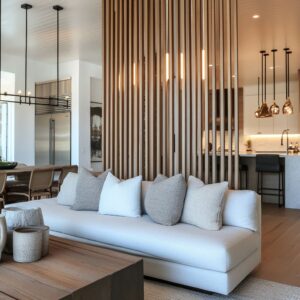When it comes to creating a living room that feels both inviting and effortlessly stylish, contemporary design offers the perfect solution. It’s a style that strikes a fine balance—combining clean lines, purposeful layouts, and subtle sophistication while ensuring that the space remains comfortable and livable.
A well-furnished contemporary living room goes beyond aesthetics, functioning as a hub for relaxation and connection.
The essence of contemporary design lies in its ability to blend minimalism with thoughtful functionality. Picture a space where every piece serves a purpose, yet nothing feels stark or cold.
This balance is achieved by layering textures, incorporating high-quality materials, and carefully selecting decor that reflects a refined yet approachable aesthetic. From soft, neutral-toned sofas to modern coffee tables with organic finishes, the goal is to craft a cohesive space that feels personal yet polished.
One of the most attractive features of contemporary elegance is its adaptability. Whether you’re inspired by modern living room ideas from metropolitan apartments or spacious homes in suburban neighborhoods, the principles remain the same.
Use neutral palettes as your base, introduce accents of natural wood or metallic finishes, and add touches of personality through carefully curated art and decor. Ultimately, the beauty of a contemporary living room is its ability to feel timeless while embracing a sense of comfort.
By balancing practicality and design, you can create a space that isn’t just beautiful to look at but also perfectly suited to your lifestyle. With the right approach, your living room can be a stylish reflection of who you are, without ever sacrificing warmth or functionality.
Centerpieces that Define the Space: Coffee Tables and Accent Features
Choosing the Perfect Coffee Table
The coffee table often acts as the centerpiece of the living room, grounding the seating arrangement and tying the entire design together. When selecting the ideal table, consider popular styles like low-profile designs made of warm wood or trendy rattan bases paired with durable stone or sleek glass tops.
These combinations provide a modern yet natural feel that complements a wide range of decor styles.
Equally important is ensuring the coffee table’s size and proportion work seamlessly with your sofa. A table that’s too large can overwhelm the space, while one that’s too small might feel disconnected from the seating arrangement.
As a general guideline, aim for a table that’s roughly two-thirds the width of your sofa and stands at a height that aligns comfortably with the seat cushions. This balance not only looks intentional but also makes the space more functional for everyday use.
Functionality is another key aspect of coffee table design. Many modern coffee tables now incorporate thoughtful features like recessed tops or open storage shelves.
These elements make it easy to organize trays, books, and decor while maintaining a polished appearance. The goal is to find a table that feels practical without sacrificing visual appeal.
Styling Your Coffee Table
Once you’ve chosen the perfect table, it’s time to style it in a way that enhances the overall aesthetic. The coffee table is more than just a surface—it’s an opportunity to showcase personality and design sensibility.
Start with a combination of textures and heights: a ceramic vase filled with greenery, a stack of beautifully bound books, and a textured tray to corral smaller items like candles or coasters. Layering is essential to create depth and visual interest.
For example, a sleek glass-top table can benefit from the warmth of wood or woven baskets, while a heavier stone table pairs well with lighter, reflective accents like metallic bowls or delicate ceramics. The idea is to create a composition that feels curated but not overly crowded, ensuring the table remains practical for daily use.
Incorporating natural elements like fresh or faux plants adds a touch of life and vibrancy to the table. Pair these with decorative objects such as sculptural pieces or small trinkets that align with your living room’s overall theme.
By thoughtfully arranging these items, you can transform a functional piece of furniture into a stylish focal point that complements your space.
The Role of Sofas: Comfort Meets Sophistication
Selecting the Right Sofa
A sofa is undoubtedly the centerpiece of any living room, serving as the foundation of comfort and the anchor of the room’s overall design. When exploring options for modern sofa designs for living rooms, consider sectional and modular styles.
These versatile pieces not only provide ample seating for family and guests but also exude a contemporary vibe that fits seamlessly into a variety of interior styles. Neutral fabrics like cream, beige, or ivory remain a top choice for achieving a clean, airy look while allowing other elements in the room to shine.
To maintain a refined aesthetic, opt for sofas with clean lines and subtle curves. Straight edges and gentle contours create a balance that feels polished yet inviting.
Upholstery materials are another crucial factor—choose options that blend durability with a luxurious feel, such as high-performance woven fabrics or plush velvets. These materials ensure the sofa remains a timeless investment while standing up to everyday use.
The size and configuration of the sofa should also reflect the needs of the room. For larger spaces, a spacious sectional can define the seating area, while a sleek modular sofa can adapt beautifully to smaller living rooms.
The right choice will not only elevate the style of the room but also make it a functional and comfortable space for relaxation.
Decorating with Throw Pillows
Throw pillows are the perfect way to enhance your sofa’s appearance while adding personality to your living room. Start by experimenting with a mix of textures and colors.
Warm earth tones like terracotta and mustard can provide a sense of warmth, while navy and other deeper shades add richness and depth to the palette. Pairing these bold accents with neutral pillows helps maintain a cohesive and balanced look.
When layering throw pillows, consider incorporating different materials to create visual interest. Chunky knits, soft linens, and smooth velvets can coexist beautifully, adding dimension to the arrangement.
The key is to strike a balance between variety and harmony—avoid using too many competing patterns or colors that overwhelm the space. For a polished look, arrange pillows in groupings of two or three on each side of the sofa.
Use larger pillows as a base and layer smaller ones in front to create depth. This thoughtful approach not only enhances the aesthetic appeal of the sofa but also makes the seating area feel inviting and well-curated.
TV Walls as Statement Elements
Designing a Functional TV Wall
The TV wall is often the focal point of a living room, combining functionality with visual appeal. Minimalist designs are ideal for creating a clean and cohesive look.
Features such as integrated storage can help keep the area organized while maintaining a polished appearance. Built-in cabinetry in natural wood finishes or light-colored materials is a popular choice, offering a modern aesthetic with a hint of warmth.
For those seeking a touch of sleekness, metallic accents, such as slim handles or trim, can add a refined edge without overwhelming the space.
The design should prioritize proportion and layout to seamlessly blend the TV into the room. Wall-mounted options help maintain a streamlined appearance, allowing the TV to feel like an intentional part of the design rather than an afterthought.
Incorporating subtle lighting—such as LED strips or soft overhead fixtures—can enhance the display area while providing a cozy ambiance for movie nights or casual gatherings. These thoughtful elements not only create a functional centerpiece but also align with popular contemporary style living room ideas.
Complementing the TV Wall with Decor
While the TV serves as the main focus, surrounding decor can elevate the overall appeal of the wall. Adjacent shelving or consoles provide opportunities for subtle styling that adds depth and character to the space.
Small sculptures, such as abstract or geometric designs, can introduce an artistic element, while potted plants bring in a touch of greenery and freshness. For a more personal touch, arrange a selection of hardcover books with coordinating spines, mixing them with decorative objects for balance.
The key to decorating a TV wall is restraint. Overcrowding the space with too many items can distract from the main feature.
Instead, aim for a balanced arrangement with clean lines and uncluttered surfaces. For example, a single statement vase or a low-profile centerpiece on a console can complement the setup without overwhelming it.
This simplicity ensures the TV wall feels cohesive and visually striking, making it a standout feature in the living room.
Decorating Walls and Incorporating Artwork
Choosing Artwork
Artwork plays a transformative role in shaping the atmosphere of a living room, especially within a contemporary theme. Large-scale abstract pieces are particularly effective for adding a bold statement while maintaining the minimalist balance associated with modern design.
Opt for pieces in monochrome palettes or earthy tones, such as terracotta, deep ochre, or subtle greys, to complement the room’s neutral backdrop. These choices help maintain harmony with furniture and other decor while adding a creative touch.
When selecting frames, simplicity is key to aligning with contemporary aesthetics. Sleek black frames offer a crisp outline that enhances the artwork without overwhelming it.
Alternatively, floating frames, which create the illusion of the artwork hovering within the frame, bring a modern and refined vibe to the space. Both options allow the art to stand out while seamlessly blending with other design elements.
These thoughtful selections are integral to incorporating modern living room design ideas effectively.
Placing Artwork Thoughtfully
Strategic placement of artwork ensures it feels integrated into the room rather than an afterthought. For balance, position artwork to create symmetry with furniture arrangements.
For instance, a large painting can be centered above a sofa, mirroring the width of the seating to establish visual coherence. In cases where a single piece is used, its placement can be enhanced by decorative accents like mirrors or sconces on either side, framing the artwork and drawing attention to the wall.
Gallery walls offer another opportunity to showcase creativity and personality. Arrange a collection of smaller pieces, ensuring they share a unifying theme, such as color or subject matter, to maintain a cohesive look.
For rooms with simpler layouts, a single oversized piece can act as the focal point, commanding attention without competing with other elements. These approaches ensure the walls serve both a functional and decorative purpose, bringing depth and character to the living space.
Adding Layers with Textures and Materials
Incorporating Organic Textures
Creating a contemporary living room that feels warm and inviting often involves introducing natural textures. Materials like rattan, woven textiles, and natural wood not only enhance furniture but also provide a grounding presence that balances modern simplicity.
For example, rattan coffee tables or accent chairs add subtle detail while keeping the overall design cohesive. Wood finishes, whether light oak or walnut, are versatile and help bring a sense of nature indoors, tying the room together.
Area rugs are essential when it comes to grounding the space. Choose rugs with soft, neutral textures such as wool or cotton blends to enhance the room’s coziness.
These pieces work particularly well to delineate seating areas or add softness underfoot without drawing attention away from larger furniture. Rugs in muted tones like beige, cream, or subtle greys create a subtle foundation while allowing other decor elements to shine.
These thoughtful additions align perfectly with modern living decorating ideas, blending functionality and style seamlessly.
Balancing Hard and Soft Finishes
Achieving depth in a contemporary living room requires a careful mix of contrasting textures. Hard finishes like smooth stone or glass bring a sleek, polished look to coffee tables or accent pieces.
These materials can be paired with softer furnishings, such as plush sofas, throw blankets, and velvet or linen cushions, to maintain balance. The juxtaposition of cool and warm textures keeps the design visually dynamic without veering into clutter.
This balance extends to decor choices. For instance, a glass vase placed on a textured wood console creates a refined contrast, while soft drapes juxtaposed with metal curtain rods add sophistication to the overall aesthetic.
Textures not only add dimension but also prevent the space from feeling overly sterile or minimal. By layering materials thoughtfully, you can ensure your living room captures the essence of modernity while remaining inviting and comfortable.
Lighting as a Focal Point
Choosing the Right Fixtures
Lighting is a fundamental part of any contemporary living room, offering both functionality and aesthetic appeal. A range of options can transform your space, from woven pendant lights that introduce a natural, textured warmth to sculptural floor lamps that double as statement pieces.
Recessed ceiling lights provide a sleek and understated backdrop, ensuring the focus stays on the room’s design while offering even illumination. The key to successful lighting in a modern living room design is selecting fixtures that not only complement the space but also enhance its overall vibe.
Adjustable lighting is another essential consideration. The ability to switch between brighter settings for daytime activities and softer, ambient lighting for evenings helps create a versatile atmosphere.
Dimmer switches or smart lighting systems allow you to adapt the room’s brightness seamlessly, ensuring the space feels comfortable no matter the time of day or the mood you want to set.
Layering Light Sources
Layering light sources adds depth and ensures all areas of the living room are well-lit without overwhelming the space. Combining overhead lighting with accent pieces like table lamps or wall sconces can provide focused illumination on key areas, such as coffee tables or artwork.
For example, a strategically placed lamp can bring attention to a gallery wall, while recessed lighting highlights built-in shelving or a media console. Incorporating natural light is equally important in layering.
Position your furniture to take full advantage of large windows or glass doors, letting sunlight enhance the room’s brightness during the day. Combining these layers creates a dynamic lighting scheme, ensuring the room transitions beautifully from daytime to evening while accentuating its modern and comfortable style.
Bringing Nature Indoors: Greenery and Plants
Adding Indoor Plants
Incorporating indoor plants into your living room design not only adds a refreshing visual appeal but also enhances the overall atmosphere with natural elements. Greenery has been proven to improve air quality and create a calming environment, making it a key addition to a stylish space.
Popular plant choices include fiddle-leaf figs, with their bold, sculptural leaves that make a striking focal point; succulents, which require minimal care and add a modern touch; and tall potted greenery like palms or snake plants that can frame corners or fill vertical spaces effortlessly. When choosing plants, consider their size and placement in relation to your furniture and room layout.
Tall plants work wonderfully next to sofas or in empty corners, while smaller options like succulents or ferns can sit neatly on coffee tables, shelving units, or window sills. The addition of greenery can transform a space into a vibrant, inviting area without overwhelming the clean lines typical of modern living design ideas.
Styling with Planters
The right planters play a crucial role in integrating plants seamlessly into the design. Planters should complement the room’s overall aesthetic, ranging from sleek ceramic pots with matte finishes for a contemporary vibe to woven baskets that add organic texture.
Metallic finishes can also introduce a hint of sophistication, while earthy terracotta pots keep the look grounded and relaxed. Placement is another essential aspect.
Arrange planters in pairs or groups to achieve symmetry and balance, especially when styling around furniture like sofas or sideboards. For example, a cluster of three pots with varying heights can create a visually dynamic centerpiece near a seating area, while a single, tall planter can anchor a minimalist corner.
Matching the planters’ material and color to other decor elements ensures a cohesive and polished look, allowing plants to shine as natural accents in the room.
Window Treatments and Their Impact
Choosing Curtains and Shades
Window treatments are a crucial element of any well-designed living room, serving both functional and aesthetic purposes. When selecting curtains and shades, the choice of fabric can significantly influence the room’s overall atmosphere.
Sheer panels are an excellent option for maximizing natural light while maintaining a soft, airy look. They allow sunlight to filter through without overwhelming the space, making them ideal for a bright and inviting modern interior design living room.
Textured shades, such as woven bamboo or linen, add depth and interest while offering flexibility for light control. These can be layered with neutral-toned drapes to create a polished and sophisticated look.
Neutral colors like ivory, taupe, or light grey are versatile and ensure the focus remains on the room’s decor while framing the windows elegantly. For privacy, consider pairing sheer curtains with blackout roller shades that can be easily adjusted based on the time of day.
Framing Windows with Style
Windows are more than just sources of light—they’re an architectural feature that can enhance the overall aesthetic of a living room. Thoughtful framing with well-chosen treatments can highlight outdoor views or create a sense of symmetry within the space.
For example, tall drapes that extend from ceiling to floor can make windows appear larger and ceilings higher, enhancing the room’s proportions. Matching curtain rods and hardware to the room’s decor ensures consistency and adds a layer of detail to the design.
Matte black or brushed brass rods are popular choices for contemporary spaces, providing a sleek and cohesive look. Additionally, the placement of rods slightly above and beyond the window frame allows the curtains to stack neatly to the side, ensuring the view remains unobstructed and the room feels open and connected to the outdoors.
This balance of function and style makes window treatments an integral part of achieving a well-rounded design.
The Finishing Touch: Small Decor and Accessories
Choosing Small Decorative Pieces
Small decor items often carry the personality of a living room, giving the space a unique and curated feel. Pieces like ceramics, woven baskets, hardcover books, and sculptures bring character and texture without overwhelming the overall design.
For instance, a handmade ceramic vase can add an artisanal touch, while a stack of artfully chosen books introduces both visual appeal and a personal story. Sculptures in modern shapes, whether abstract or geometric, can serve as focal points on shelves or coffee tables.
Seasonal decor is another excellent way to keep your space feeling fresh and inviting. The key is to rotate smaller items—such as swapping out pillows, throws, or even floral arrangements—without disrupting the room’s consistent style.
This allows you to embrace new trends or celebrate holidays while maintaining the cohesive aesthetic of your space. These thoughtful updates align seamlessly with popular modern living room decor ideas, ensuring your space remains both stylish and adaptable.
Arranging Decor Strategically
How you arrange your decor is just as important as the pieces you choose. Balance and harmony are essential to achieving a polished look, and grouping items in odd numbers is a time-tested design trick that adds a sense of natural flow.
For example, a cluster of three objects—like a vase, a small sculpture, and a book—creates a balanced yet visually interesting composition. Additionally, layering objects of varying heights can add depth to your arrangement, drawing the eye upward and creating a more dynamic display.
Incorporating personal touches is another way to make your living room feel like home. Family photos in minimalist frames can sit alongside modern sculptures or planters, blending sentimentality with sleek design.
The goal is to let these personal elements complement rather than dominate the room’s aesthetic. By mixing these pieces thoughtfully, you can strike a balance between clean lines and meaningful decor, making your living room both stylish and welcoming.
How to Create a Cohesive Layout
Arranging Furniture for Functionality
A well-arranged living room begins with understanding the space you have to work with. For open-concept layouts, the key is to define distinct zones without sacrificing the flow of the room.
Anchor the seating area with a large area rug and arrange sofas or sectionals to face each other or a central feature like a TV wall or fireplace. This creates a natural conversation space while maintaining an open feel.
Additional furniture, such as accent chairs or ottomans, can help fill gaps and make the room feel complete without overloading it. For smaller living rooms, maximizing space is essential.
Opt for furniture with dual purposes, like a coffee table with built-in storage or a modular sofa that can adapt to the room’s dimensions. In either case, leave enough room to move comfortably around the space.
Creating conversational areas, where furniture is arranged to encourage interaction, makes the room more inviting and functional. These principles work seamlessly for a range of modern living area ideas, allowing flexibility while keeping the design cohesive.
Maintaining Visual Flow
Visual flow ensures that every piece in the room feels like part of a unified whole. Start by aligning furniture with the room’s architectural features, such as windows, walls, or built-ins.
For example, placing a sofa parallel to a large window can help create balance, while side tables or consoles can fill in awkward spaces without disrupting the overall flow. Ensure pathways are clear and maintain a sense of openness by avoiding furniture placement that blocks natural light or foot traffic.
Avoid overcrowding by being selective with decor and furniture. Every piece should serve a purpose, whether functional or aesthetic, and contribute to the overall harmony of the space.
Consider the relationship between height and scale—low-profile furniture works well in contemporary rooms, while taller shelving or artwork can add dimension without feeling overpowering. The goal is to create a room that feels spacious and intentional, making it both visually appealing and practical for everyday use.
Common Mistakes to Avoid
Overdecorating: How to Keep the Contemporary Style Clean and Uncluttered
A common pitfall when designing a modern contemporary living room is overdecorating. While it’s tempting to fill the space with every stylish piece you find, too many items can create visual chaos, detracting from the clean and open feel that defines contemporary design.
Focus on selecting a few key decor pieces that complement each other and serve a purpose. For example, a single statement vase on a console table or a curated arrangement of books and sculptures on a shelf is often more impactful than an assortment of unrelated items.
Additionally, resist the urge to layer too many textures or colors. A cohesive palette with subtle variations can make the room feel sophisticated and intentional.
Keeping surfaces like coffee tables or media consoles uncluttered ensures the room feels spacious and inviting, rather than crowded and overwhelming.
Ignoring Scale: Ensuring That Furniture and Decor Are Proportionate to the Room Size
Ignoring scale can disrupt the balance of your living room design. Large furniture pieces in a small room can make the space feel cramped, while overly small items in a large room can appear lost.
To avoid this, choose furniture and decor that are proportionate to the room’s dimensions. For example, a low-profile sectional works well in an open-plan space, while a compact loveseat and sleek accent chairs can maximize comfort in smaller rooms without overwhelming the layout.
Pay attention to the height of your furniture and decor as well. Tall bookcases or oversized artwork can draw the eye upward and create a sense of grandeur in larger rooms, but they may feel overpowering in a more compact setting.
By matching the scale of your elements to the room’s size, you create a balanced and harmonious design.
Skipping Functionality: Balancing Beauty with Practicality in Every Element
A beautiful living room should also be functional. Skipping functionality in favor of aesthetics can lead to a space that looks great but doesn’t work for daily use.
Ensure every piece serves a purpose—whether it’s a coffee table with built-in storage, a sectional that accommodates family and guests, or lighting that adjusts to suit different times of the day.
Consider how the room will be used. If your living room is a space for socializing, arrange the seating to encourage conversation.
For a family-friendly room, opt for durable fabrics and multi-purpose furniture that can withstand everyday wear and tear. By balancing practicality and design, you’ll create a space that’s as enjoyable to live in as it is to look at.
Conclusion
Creating a stylish and comfortable contemporary living room is about finding the perfect balance between functionality and aesthetics. From selecting versatile furniture like sectionals and coffee tables to incorporating thoughtful decor and textures, each element contributes to a cohesive and inviting space.
Lighting, greenery, and window treatments further enhance the ambiance, while carefully curated artwork and accessories add personality and depth.
By focusing on proportion, simplicity, and purposeful design, you can achieve a room that reflects modern elegance without feeling overly formal or impersonal. For inspiration, browse images of modern living rooms that showcase how these elements come together to create harmonious and functional spaces.
With the right approach, your living room can be a reflection of your style while remaining welcoming and practical for everyday use.

